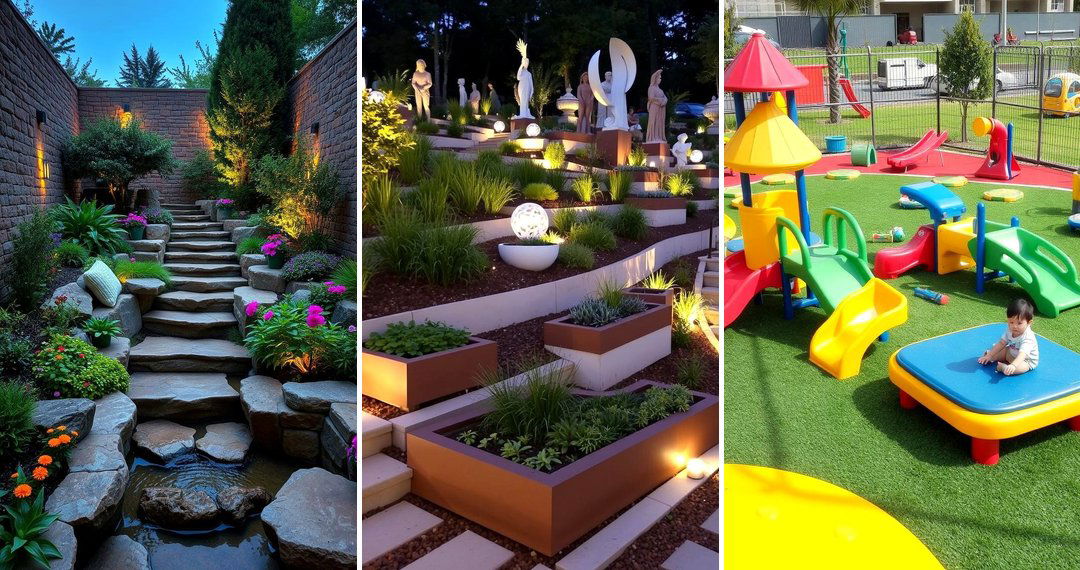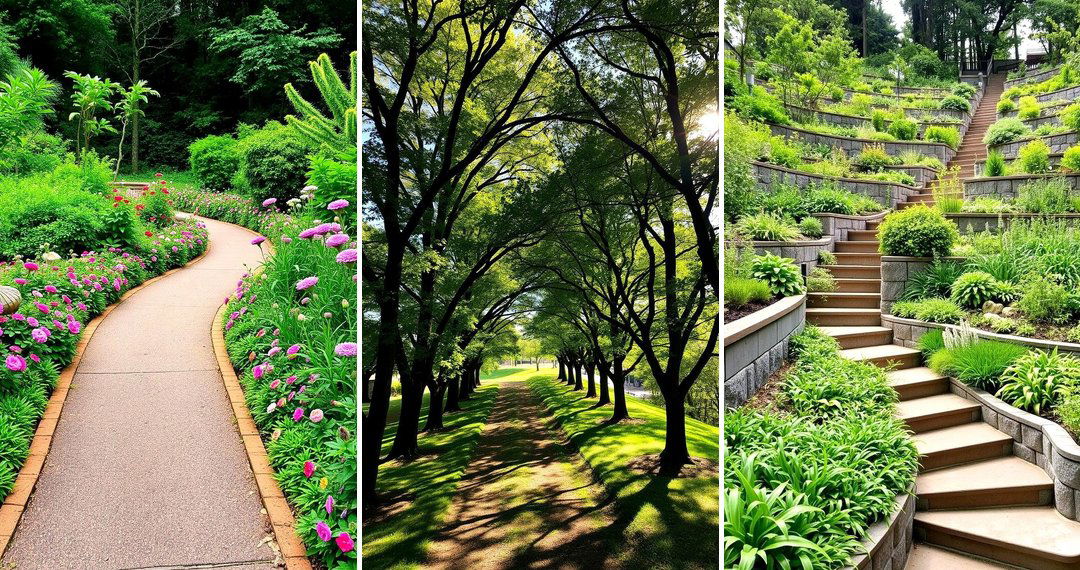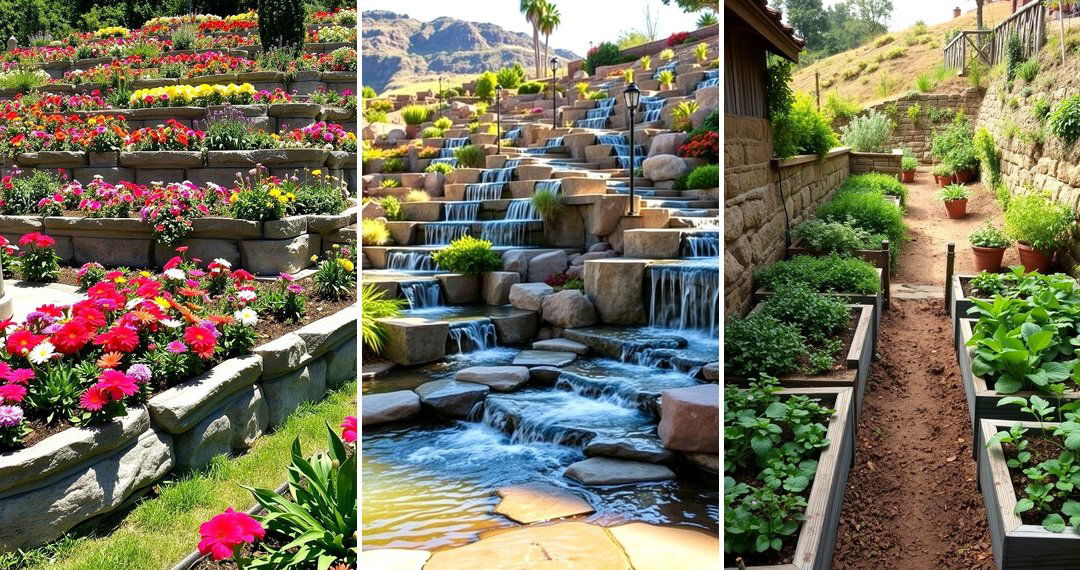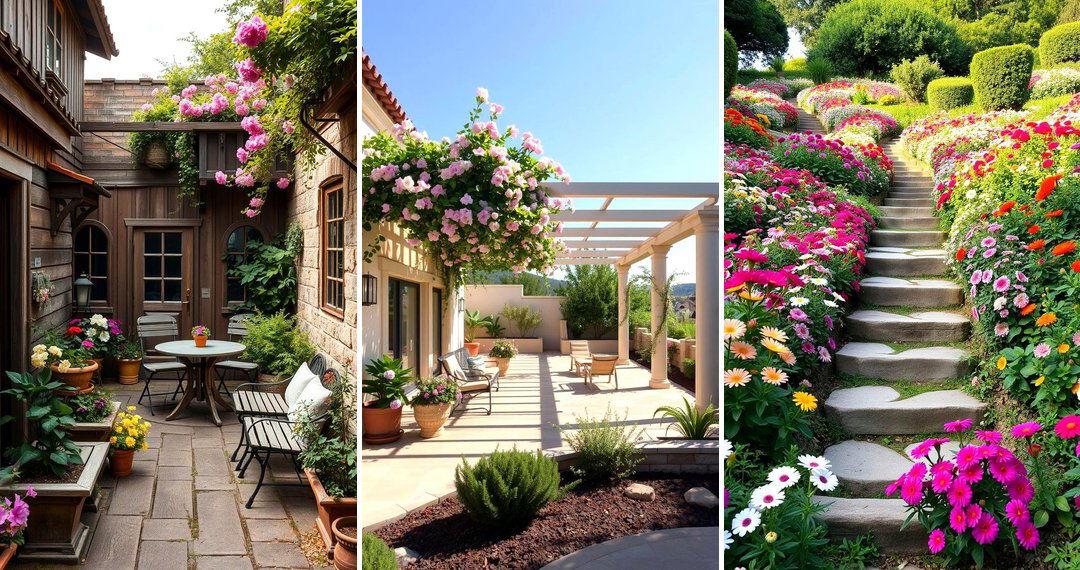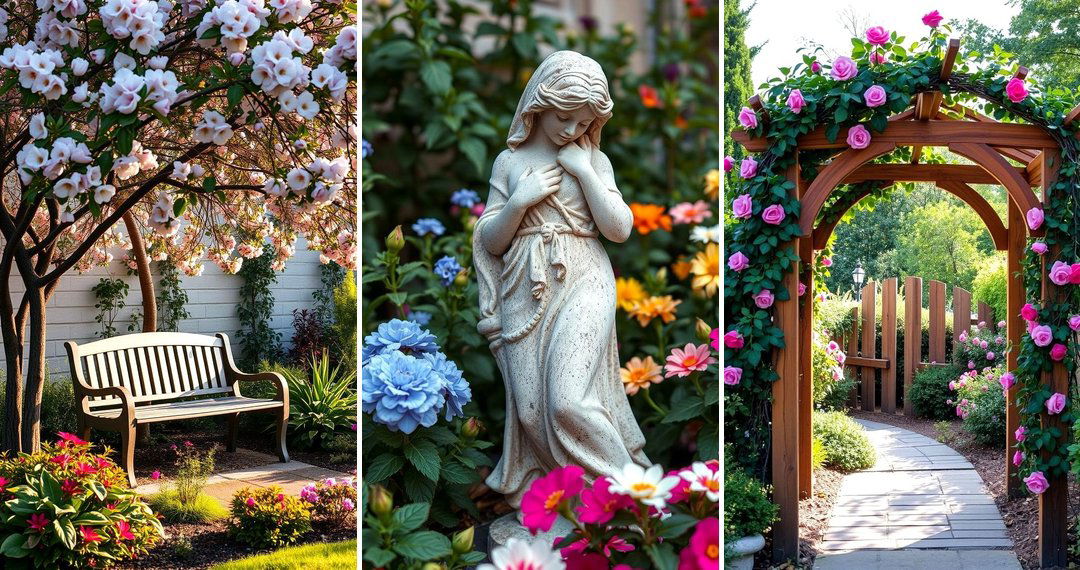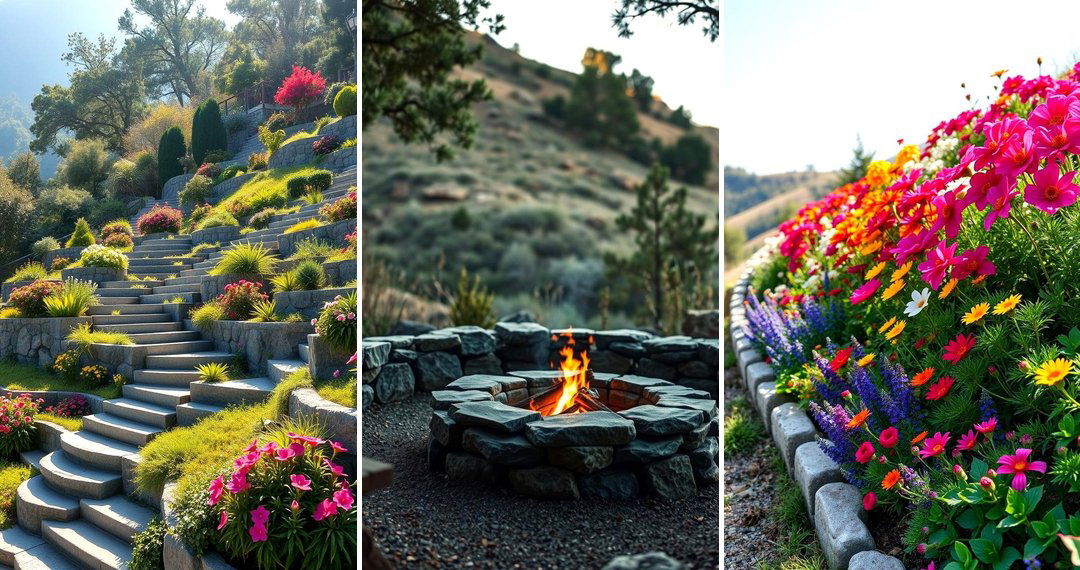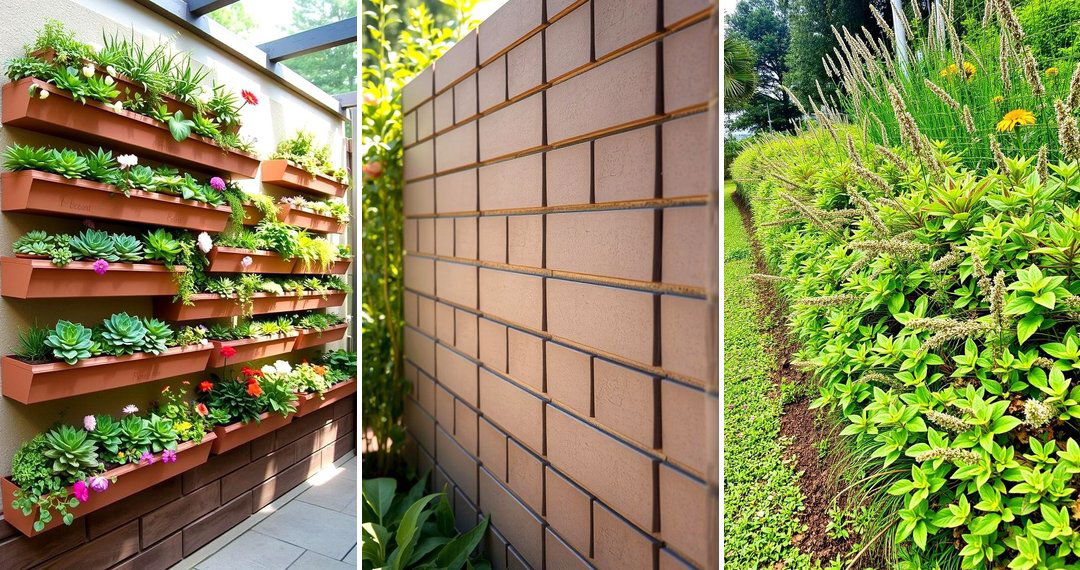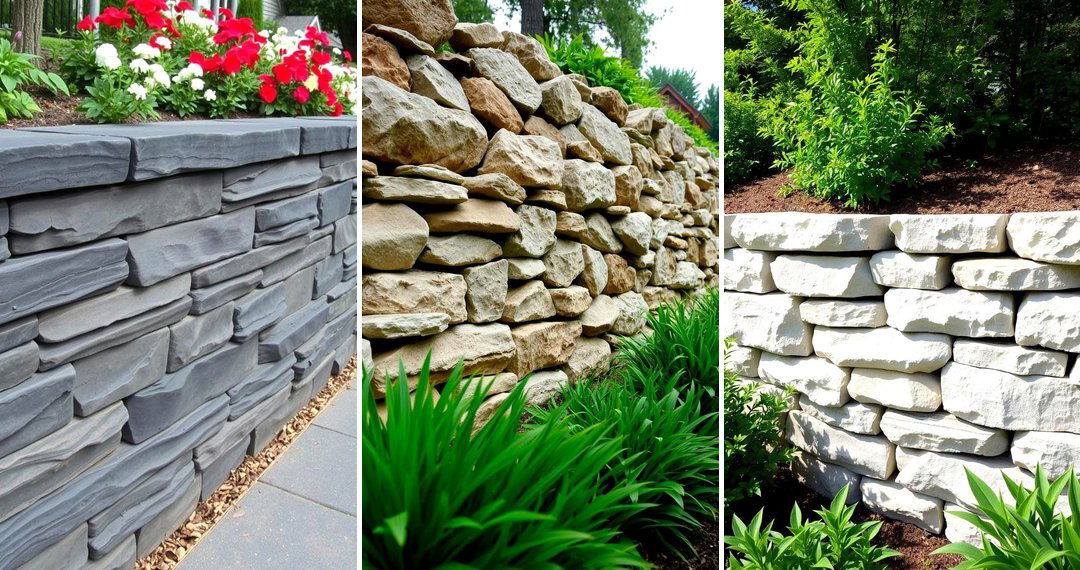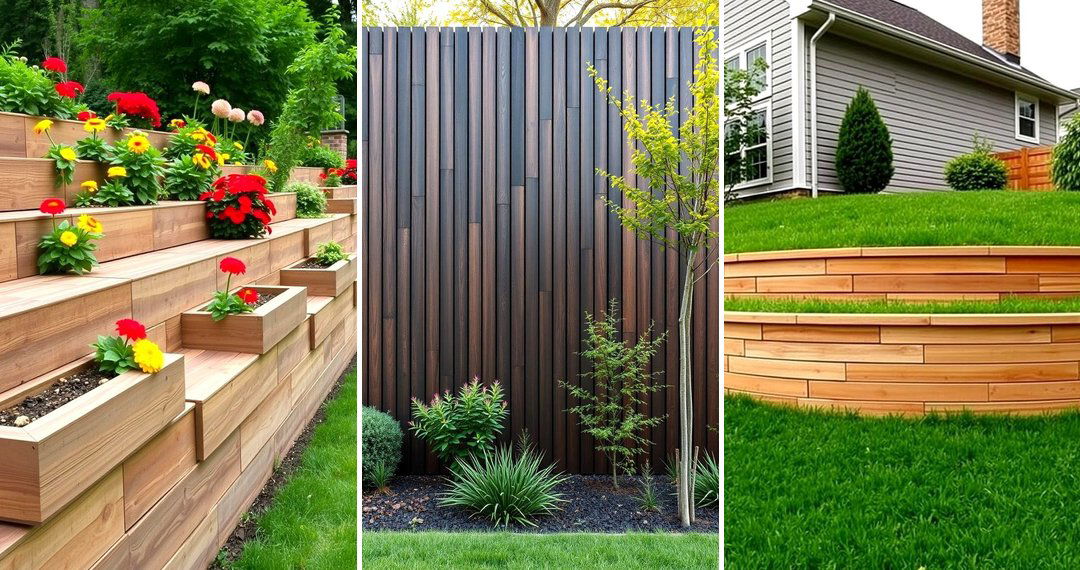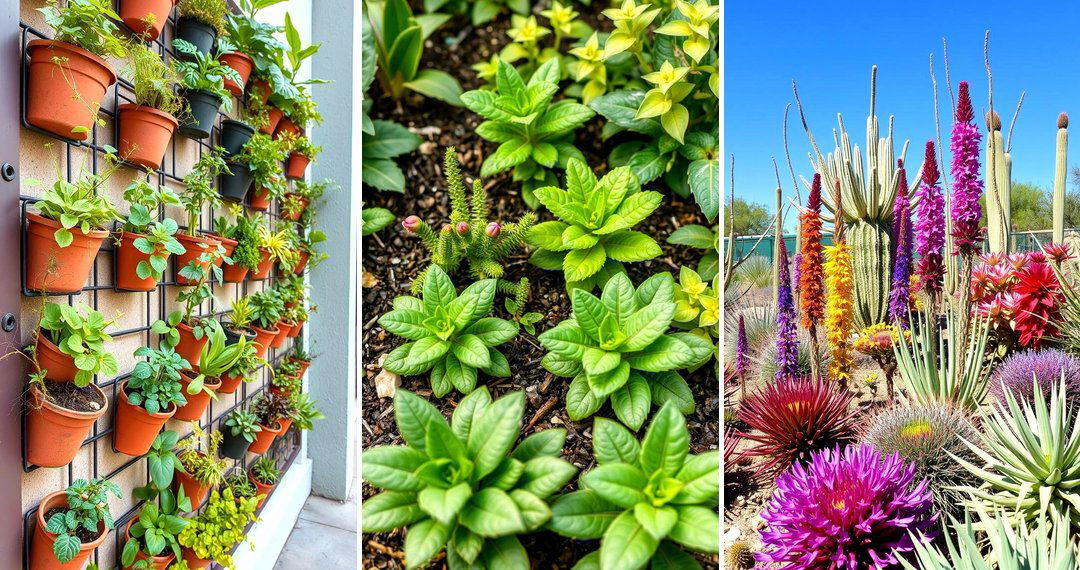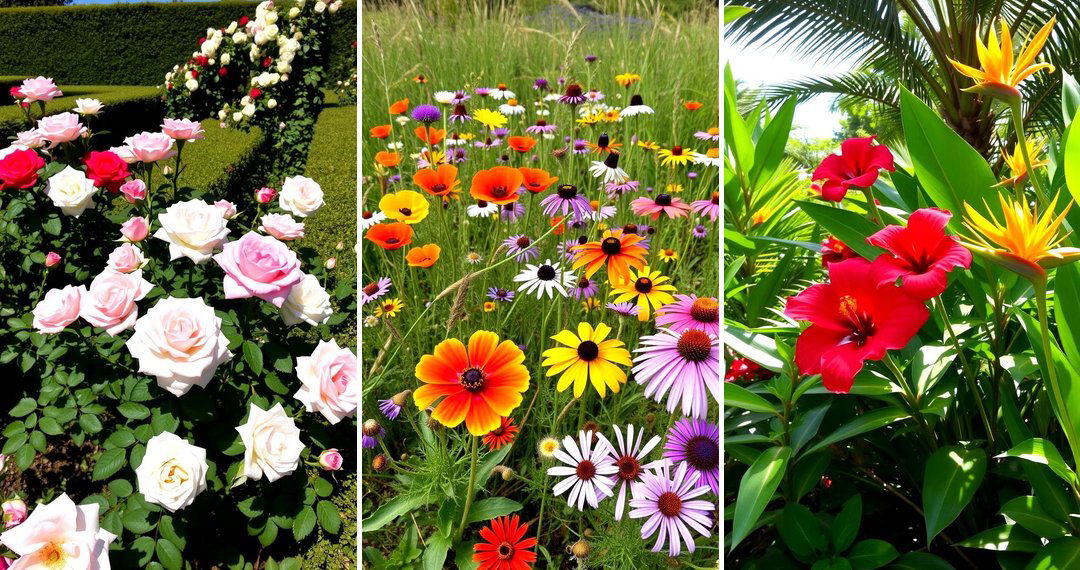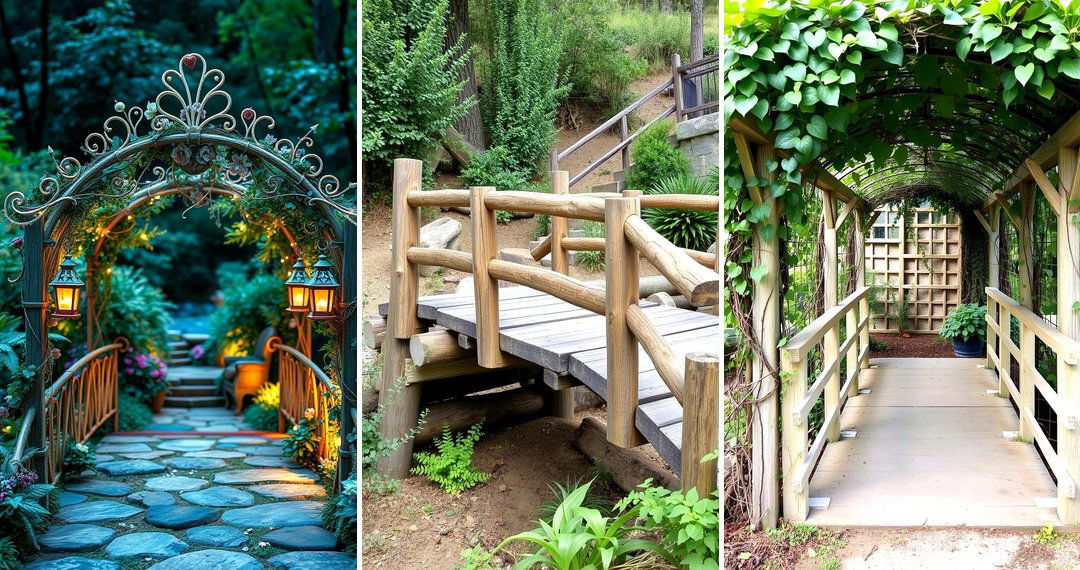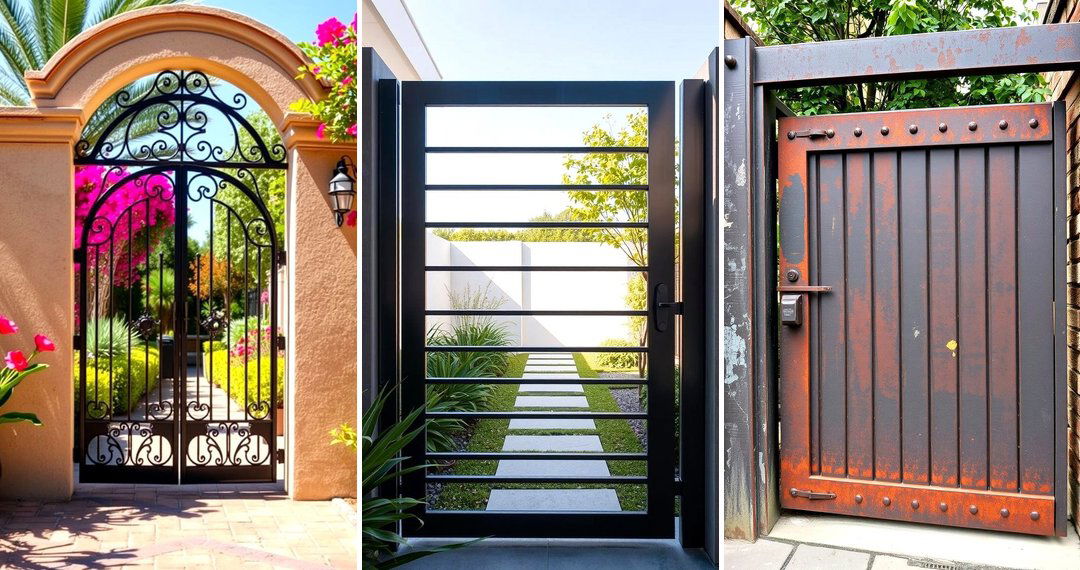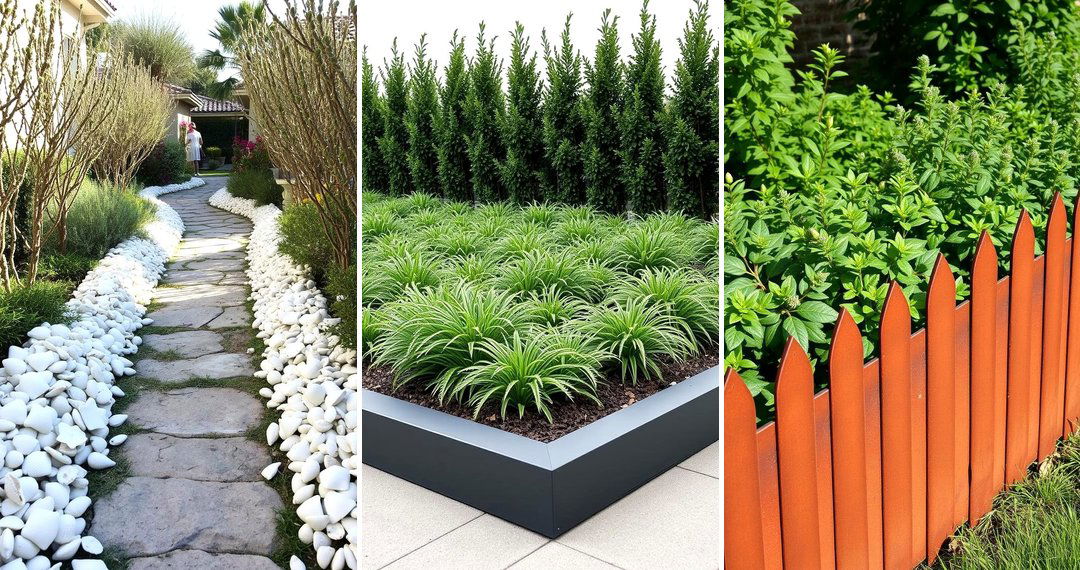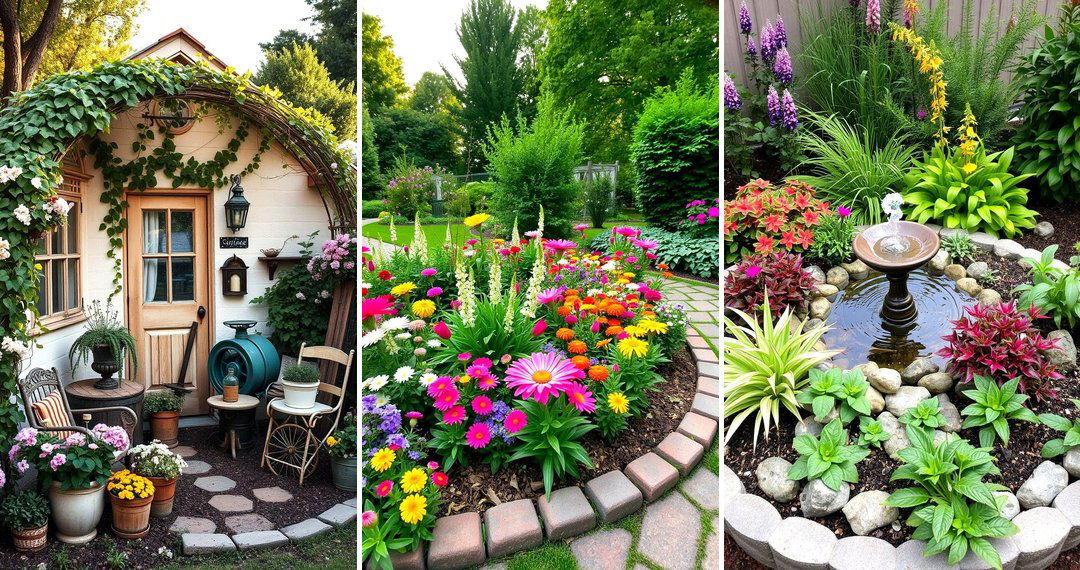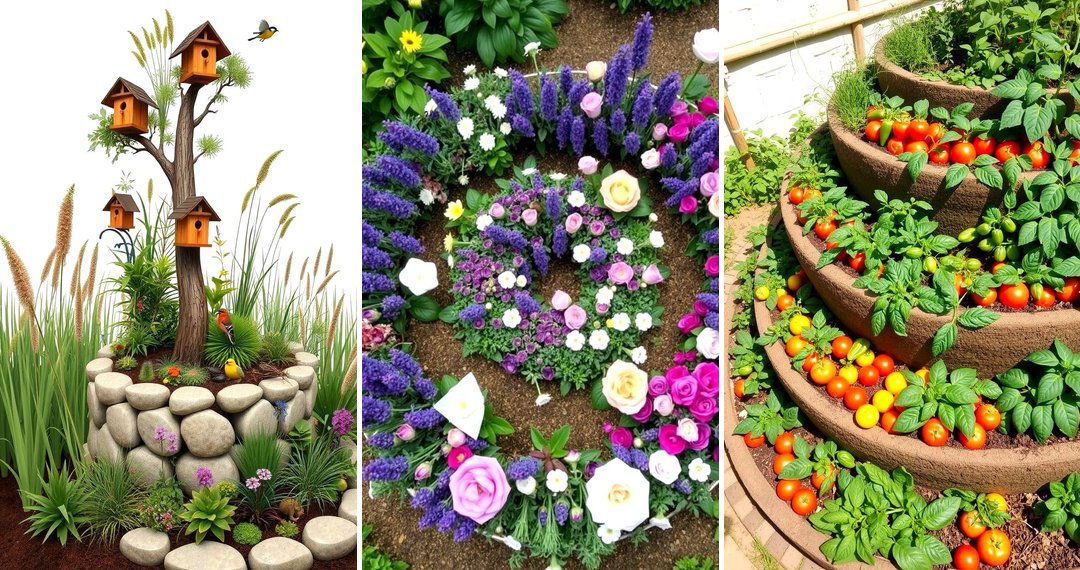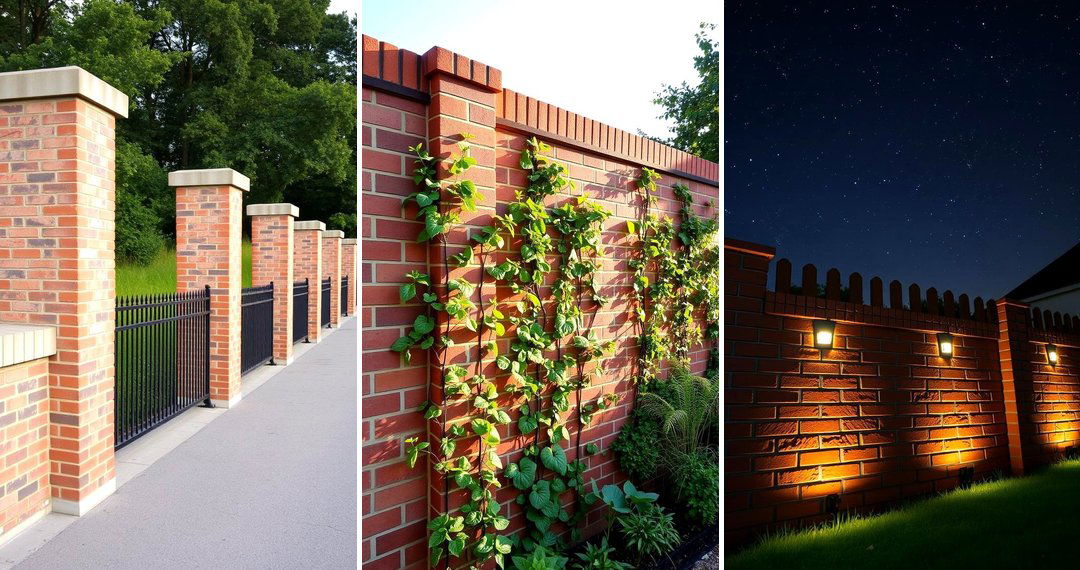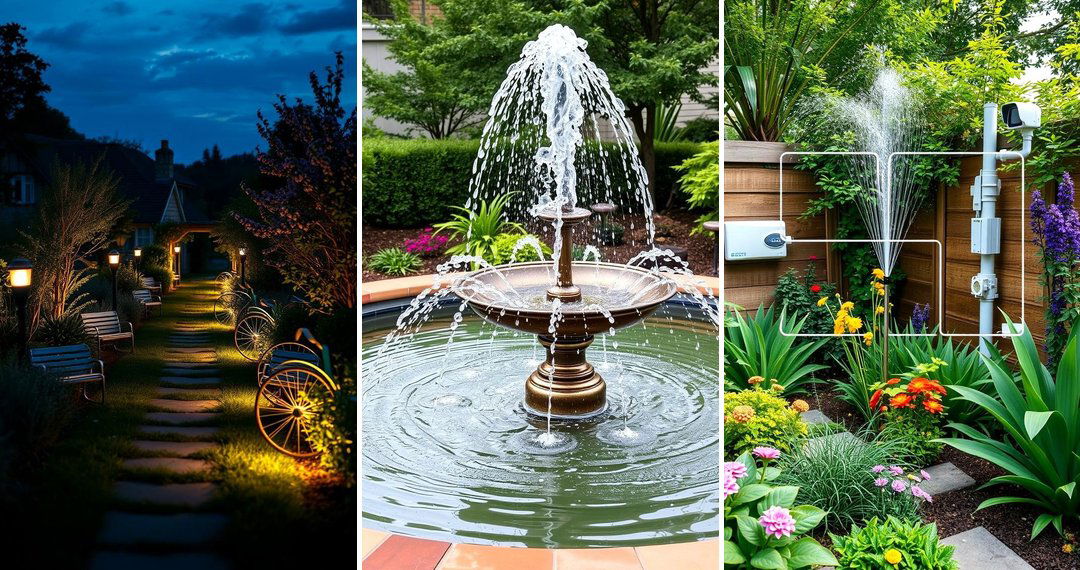A captivating exploration of transforming challenging sloped spaces into stunning gardens awaits you. Discover how creative design, practical planning, and a touch of nature can turn every incline into a thriving oasis. These 24 Sloped Garden Ideas blend sustainability, beauty, and function to inspire both novice and seasoned gardeners. Enjoy a journey through innovative landscaping, vibrant colors, and thoughtful design details that invite growth and harmony. Get ready to uncover techniques that elevate your outdoor space and spark your creativity with 24 Sloped Garden Ideas.
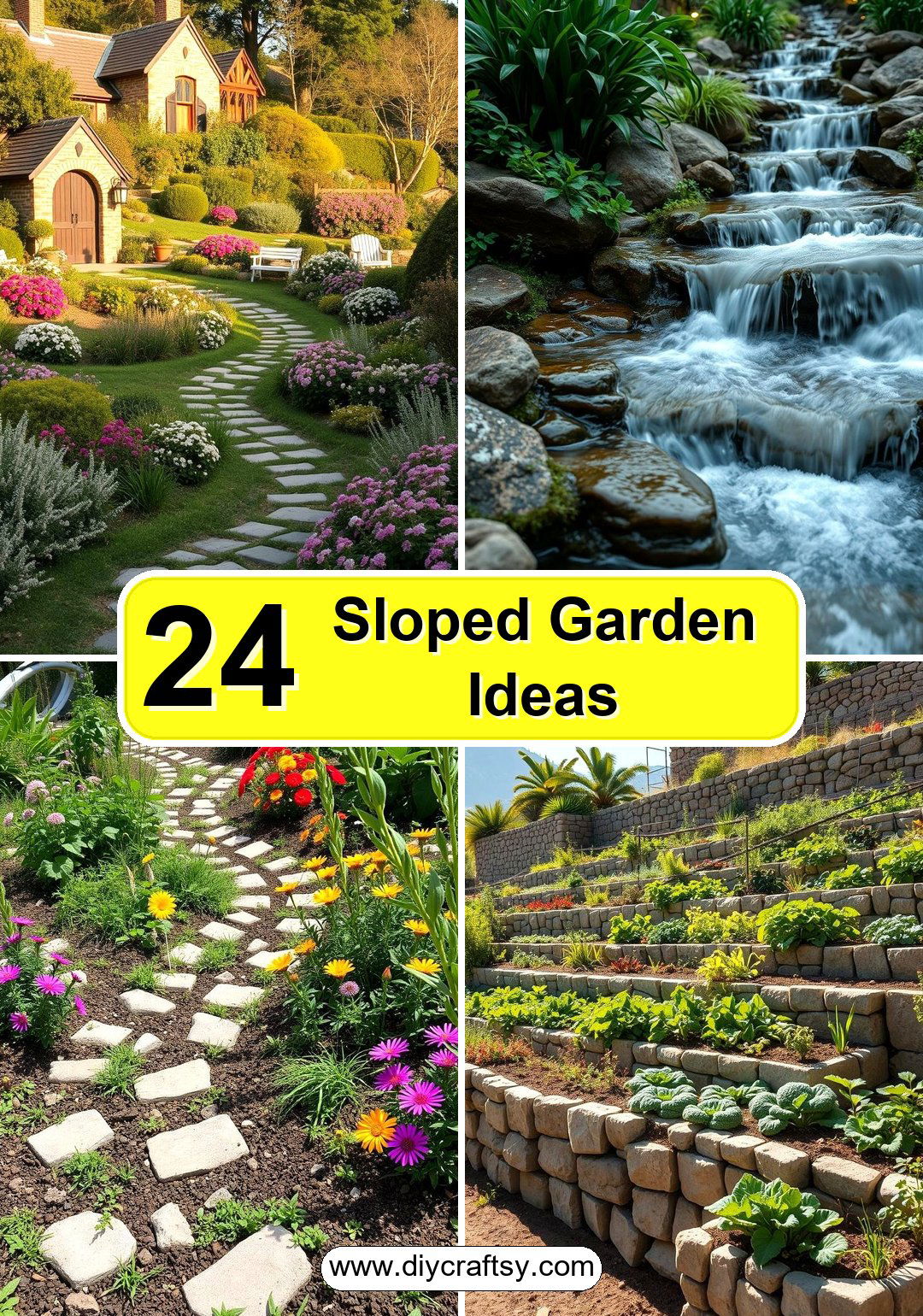
1. Terraced Vegetable Haven
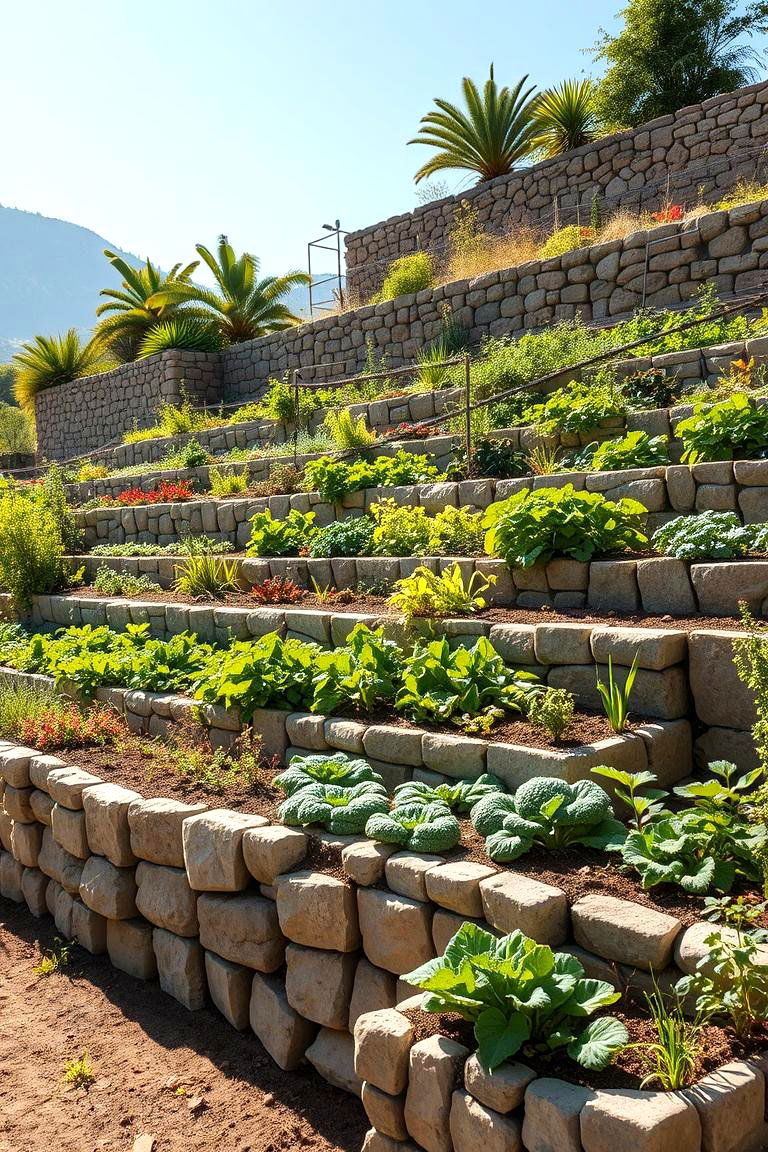
A fresh perspective unfolds as terraced vegetable gardens create level plots on sloping terrain. This approach not only maximizes growing space but also reduces soil erosion while allowing a variety of produce to thrive. By integrating retaining walls with natural stone or wood, the design exudes rustic charm and practicality. The layered arrangement simplifies irrigation and maintenance, offering a sustainable solution for food production. Gardeners can enjoy the satisfaction of harvesting diverse crops while preserving the natural slope, making it a rewarding, eco-friendly endeavor.
2. Native Flower Sanctuary
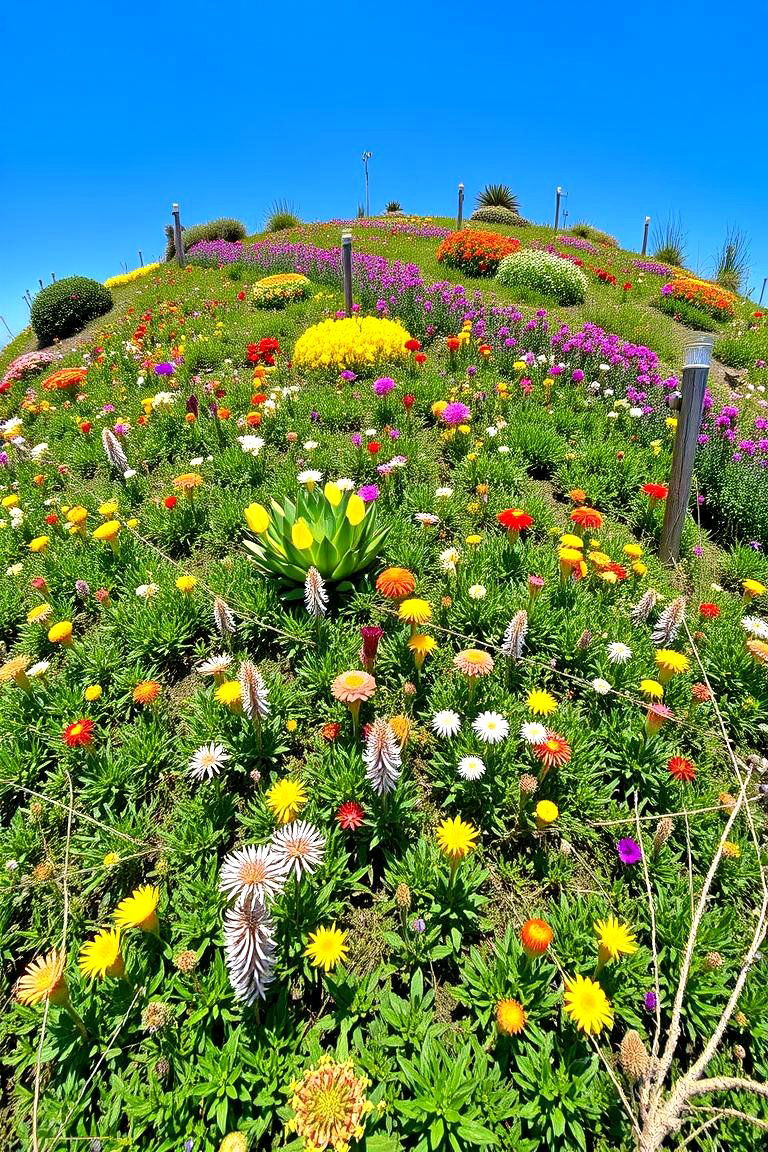
The charm of native flower sanctuaries transforms slopes into vibrant displays of local flora. With an array of indigenous blooms arranged in cascading beds, this design boosts biodiversity and supports local pollinators. Additionally, the natural adaptation of native species to the climate minimizes watering needs and maintenance. The gently sloping layout enhances visual appeal, creating a seamless transition between different garden layers. Embracing the beauty of regional plants encourages a sense of place and community, ensuring that the garden remains both sustainable and delightful throughout the seasons.
3. Rock Garden Oasis
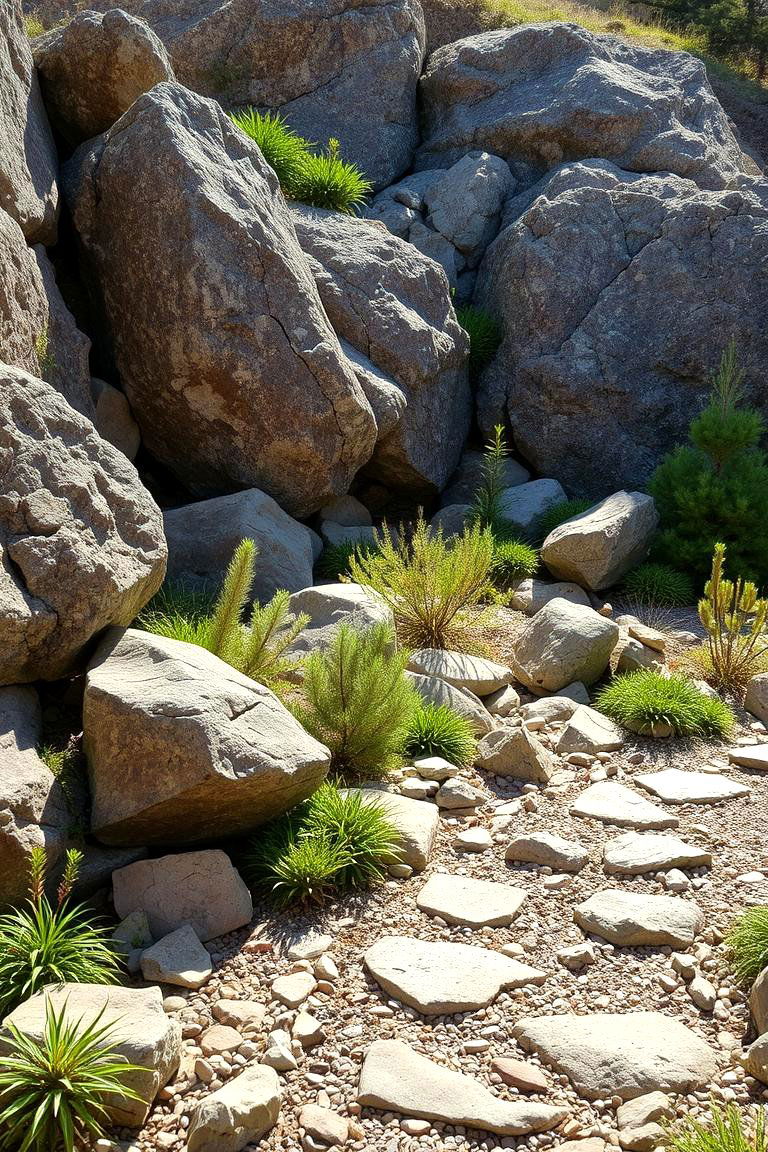
This innovative idea turns a challenging slope into a rock garden oasis, blending rugged natural elements with delicate plant life. Strategically placed boulders and stones serve as natural retaining walls while adding texture and character. Dwarf shrubs, alpine plants, and succulents fill the gaps, thriving in well-drained soil. The design minimizes water usage and creates a modern, minimalist aesthetic. Gardeners benefit from reduced maintenance and an eye-catching landscape that highlights the intrinsic beauty of rocky terrain, ultimately turning an underutilized slope into a serene retreat.
4. Cascading Water Feature Garden
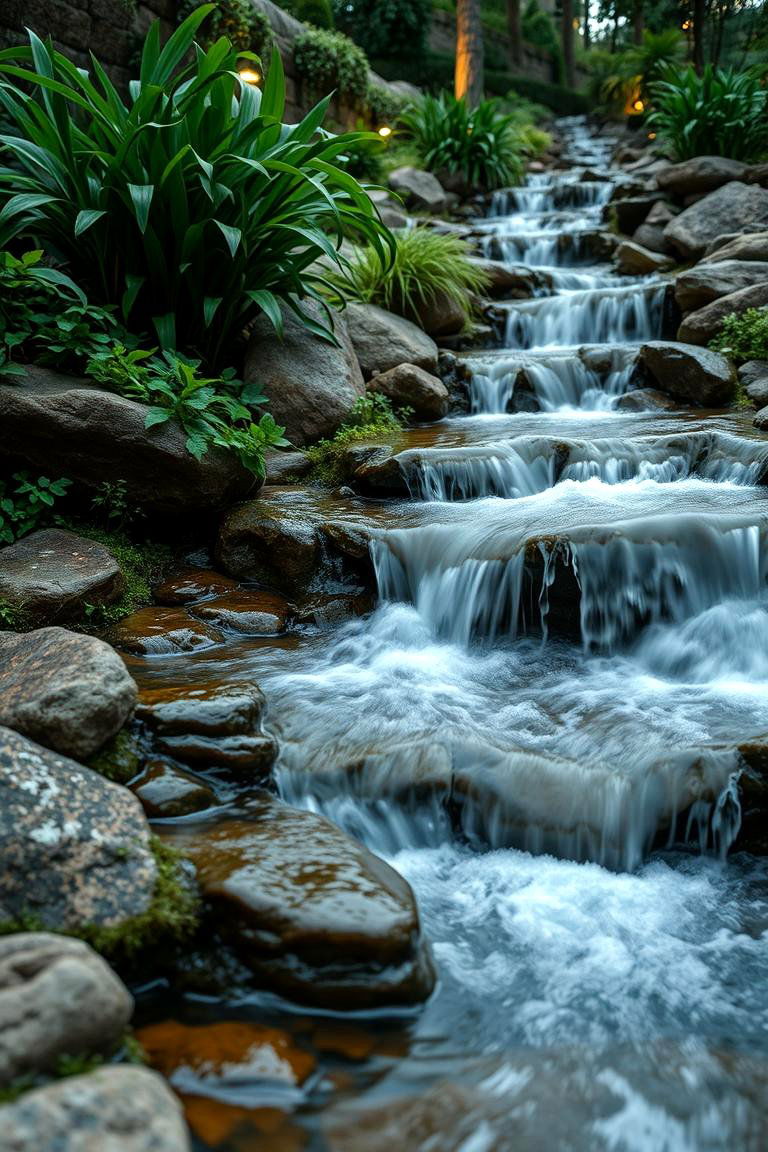
With a harmonious blend of water and greenery, cascading water feature gardens elevate sloped landscapes into dynamic retreats. A series of gentle water flows over strategically placed stones creates a soothing ambiance while naturally irrigating planted areas. This design not only adds a sensory element of sound and motion but also cools the surrounding environment. By integrating water-efficient features and drought-resistant plants, the garden becomes a sustainable masterpiece. The innovative layout encourages relaxation and contemplation, offering a practical yet enchanting solution for sloped terrains.
5. Sustainable Perennial Border
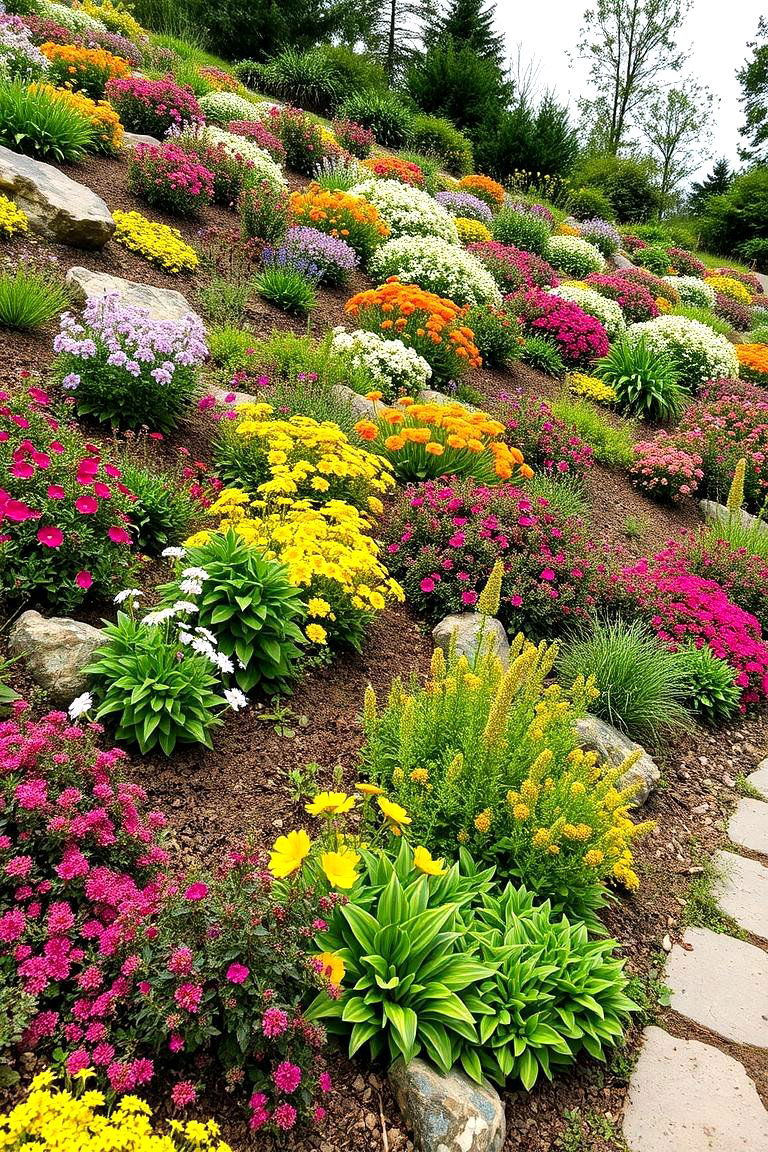
Another inspiring approach involves creating sustainable perennial borders along slopes, showcasing a variety of long-lasting flowering plants. This design takes advantage of the natural incline to form layered displays that provide seasonal color and texture. Perennials require less replanting and maintenance, making them ideal for busy gardeners. The strategic use of groundcovers minimizes erosion while conserving soil moisture. With carefully chosen species, the garden becomes a living tapestry that evolves throughout the year, offering continuous visual appeal and environmental benefits.
6. Japanese Zen Garden Slope
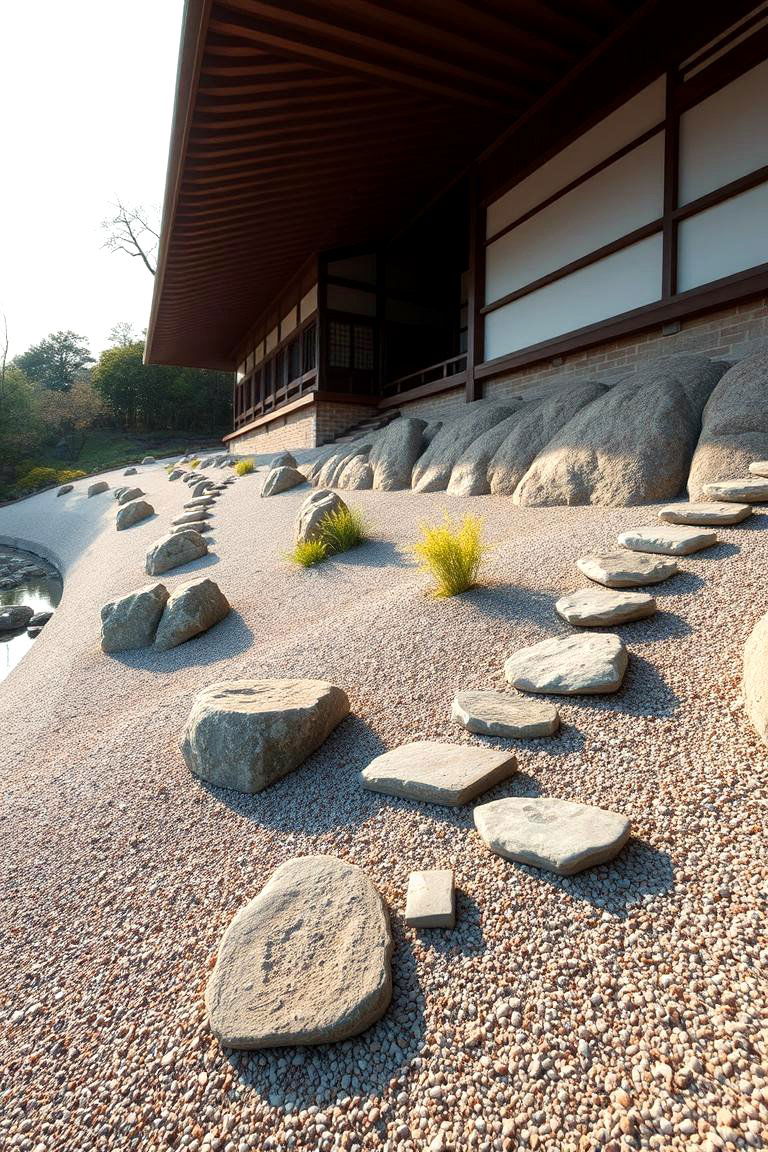
To evoke tranquility, a Japanese Zen garden slope employs minimalist design principles on challenging terrain. Featuring raked gravel, smooth stepping stones, and carefully placed rocks, the garden promotes meditation and inner peace. Lush green moss and carefully pruned shrubs add subtle color and life, creating a serene environment. This design encourages mindful gardening practices while offering an aesthetic that is both refined and natural. The integration of water elements and natural textures further enhances the soothing atmosphere, providing an ideal escape from the bustle of everyday life.
7. Wildflower Meadow on a Slope
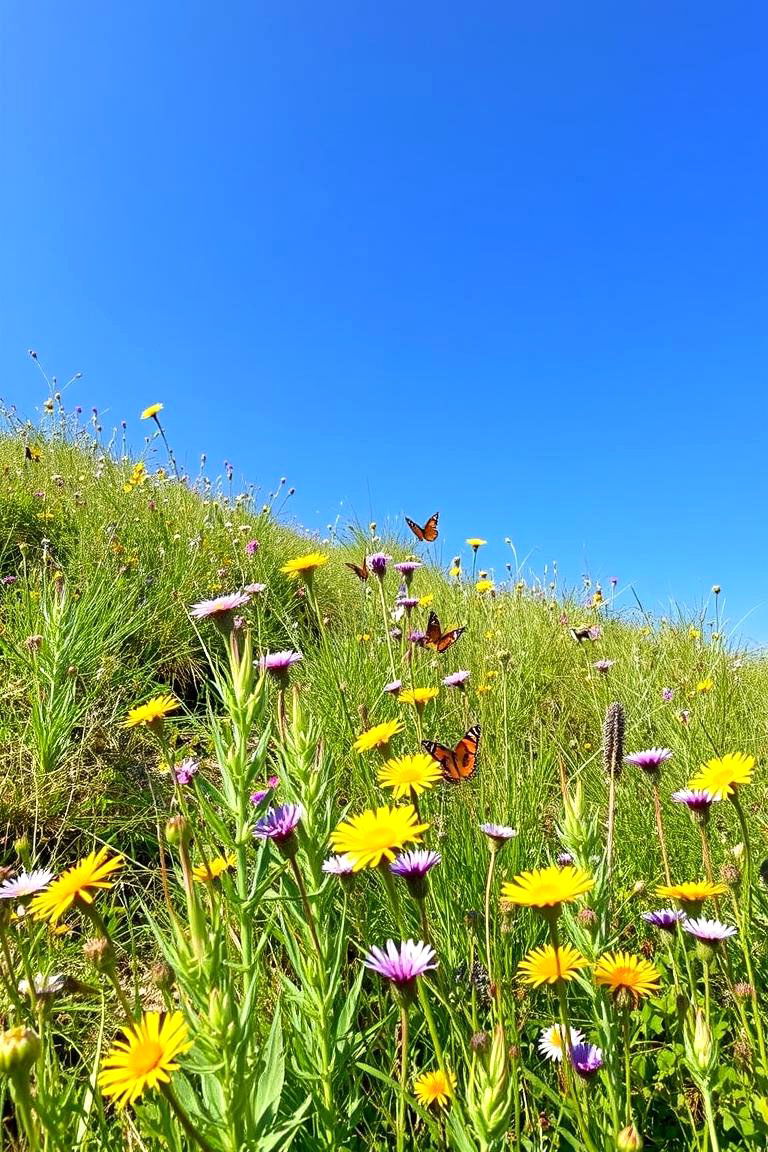
What better way to celebrate natural beauty than a wildflower meadow gracefully covering a sloping hillside? This design employs a mix of native wildflowers and grasses that flourish with minimal intervention, attracting butterflies and bees. The spontaneous burst of colors creates a dynamic landscape that changes with the seasons. Low maintenance and eco-friendly, wildflower meadows reduce the need for regular mowing and irrigation. This idea provides a picturesque, sustainable solution for sloped gardens, inviting both nature lovers and casual onlookers to enjoy its effortless charm.
8. Mediterranean Drought Garden
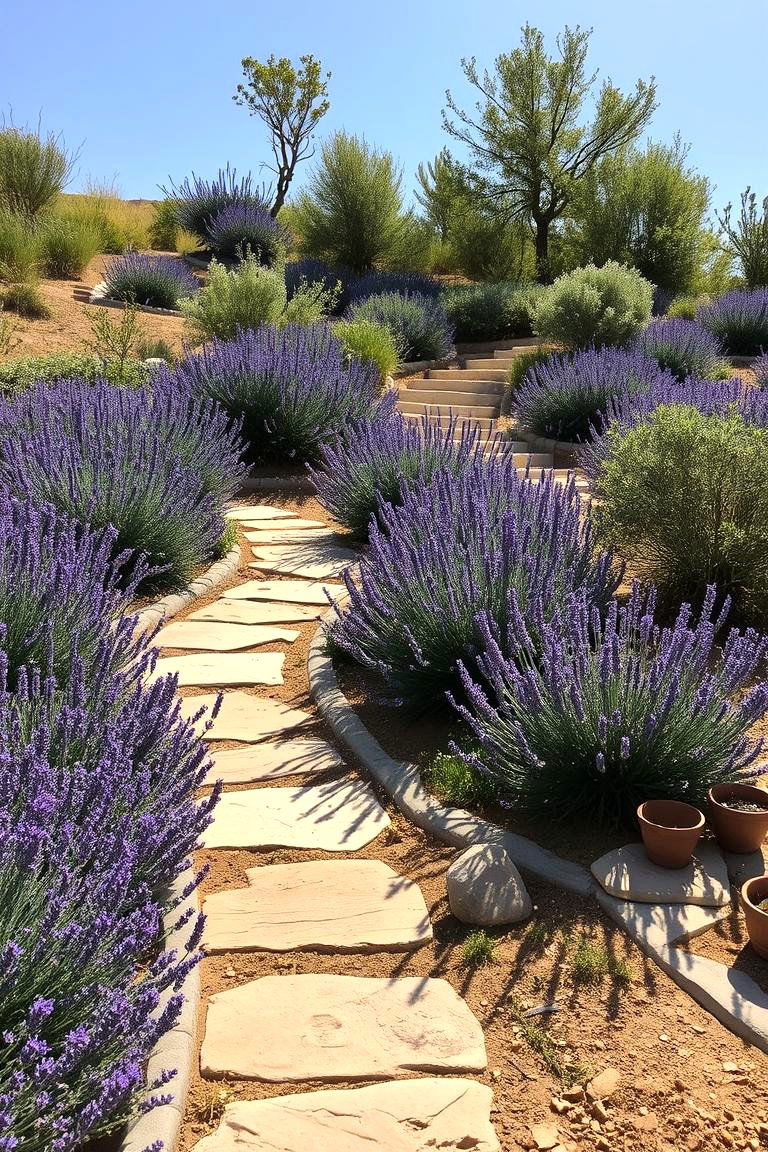
By embracing the resilient charm of Mediterranean drought gardens, slopes transform into sun-soaked landscapes that thrive on minimal water. Drought-tolerant plants such as lavender, rosemary, and olive trees create a warm, aromatic environment perfect for dry climates. The design emphasizes natural stone paths and rustic features, merging functionality with timeless beauty. This garden style reduces water consumption and maintenance, while offering a serene retreat that captures the essence of Mediterranean living. The harmonious blend of texture, color, and fragrance invites relaxation and outdoor enjoyment.
9. Artistic Sculpture Garden

Surprisingly, integrating artistic sculptures into a sloped garden creates a dynamic fusion of nature and art. The careful placement of modern or classical sculptures enhances the natural contours of the landscape. Complementary planting beds with vibrant perennials and shrubs add a burst of color that frames each art piece beautifully. This design strategy encourages creativity and offers a unique outdoor gallery that sparks conversation. Gardeners enjoy both the aesthetic appeal and the personal expression of art, turning an ordinary slope into a cultural and inspiring sanctuary that celebrates visual innovation.
10. Butterfly and Pollinator Haven
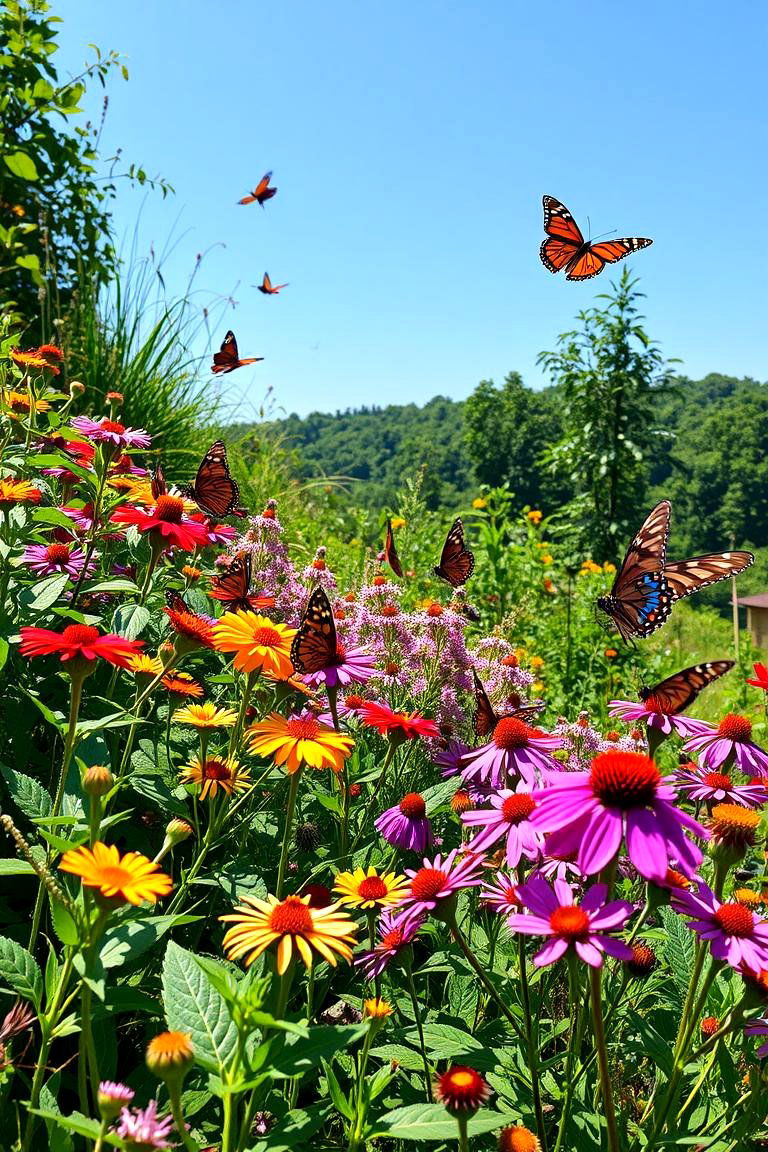
Looking to attract vibrant life to a sloped garden? A butterfly and pollinator haven incorporates a rich mix of nectar-rich plants and host species to create an inviting sanctuary for butterflies, bees, and hummingbirds. The varied elevation enhances microhabitats, promoting ecological balance. This design not only supports biodiversity but also provides an educational experience about local wildlife. The thoughtful combination of colors, scents, and textures creates a natural, lively environment. Enjoy watching nature’s pollinators flourish, contributing to a healthier ecosystem on a slope that becomes a buzzing hub of activity.
11. Shrub and Groundcover Installation
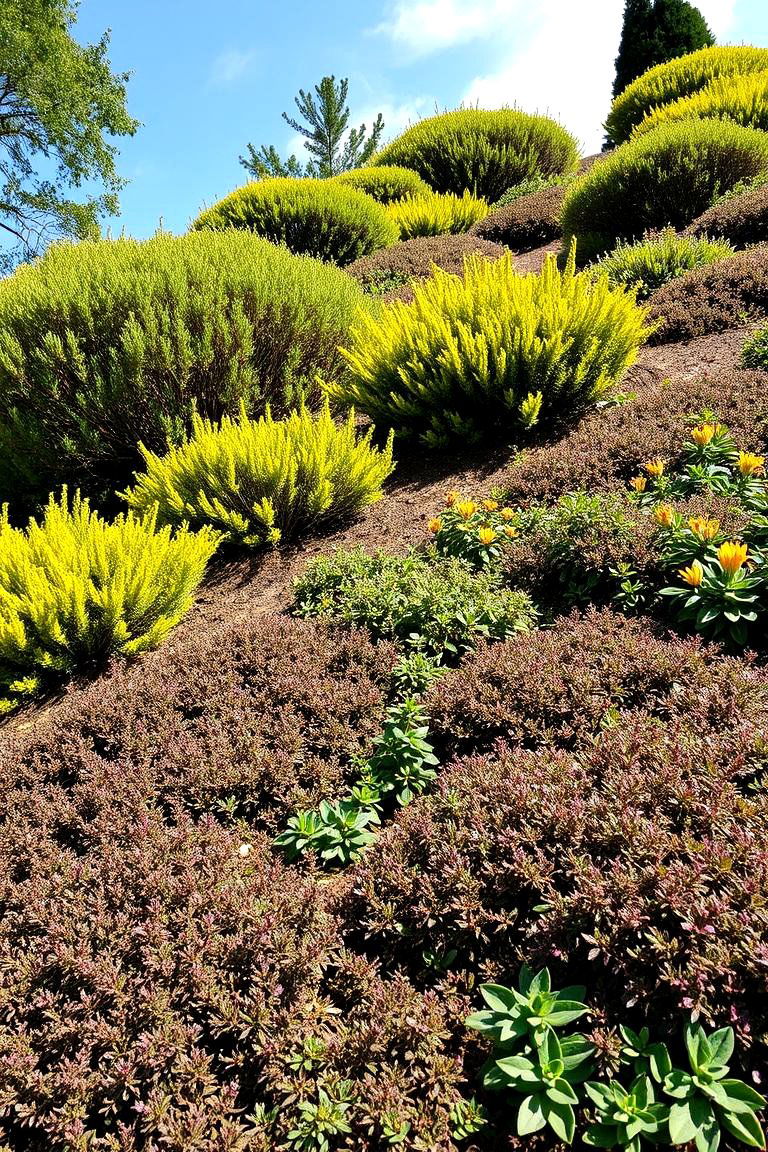
Consider a design where shrubs and groundcovers work in harmony to stabilize a sloped garden while adding depth and texture. This idea employs layered planting techniques that reduce erosion and create lush, cascading greenery. Carefully selected shrubs provide structure and seasonal interest, while low-growing groundcovers fill in gaps with vibrant color and texture. The result is a resilient, low-maintenance garden that offers year-round appeal. The strategic arrangement enhances natural drainage and adds a dynamic visual rhythm, making the slope both practical and beautifully inviting for everyday enjoyment.
12. Sensory Garden Experience
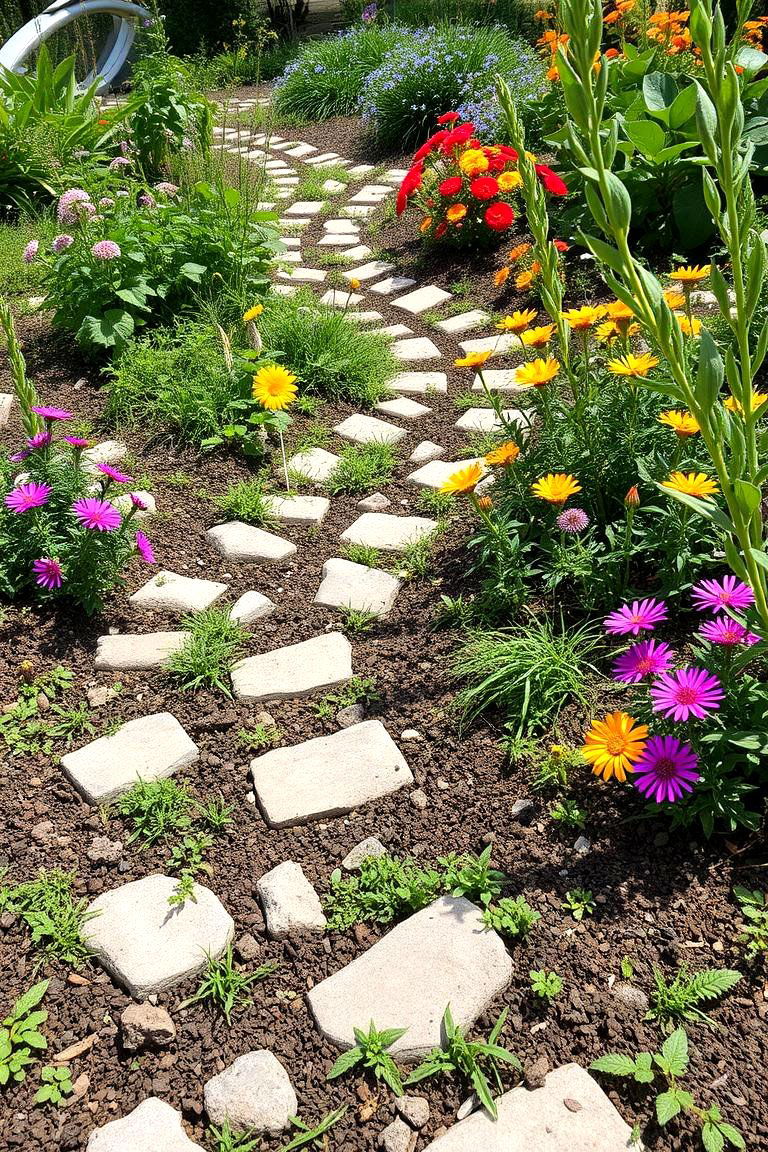
With sensory gardens, every step on a slope becomes a delightful exploration of textures, aromas, and colors. Soft, fragrant herbs mix with visually striking blooms to engage all the senses. Tactile paths and varied plant heights offer a rich, multi-sensory experience designed for relaxation and discovery. This approach not only enhances the garden’s beauty but also provides therapeutic benefits. The careful selection of plants ensures a balance of fragrance, touch, and visual appeal, inviting visitors to immerse themselves in a landscape that soothes the mind and invigorates the spirit, all on a gently sloping terrain.
13. Slope-Integrated Herb Garden
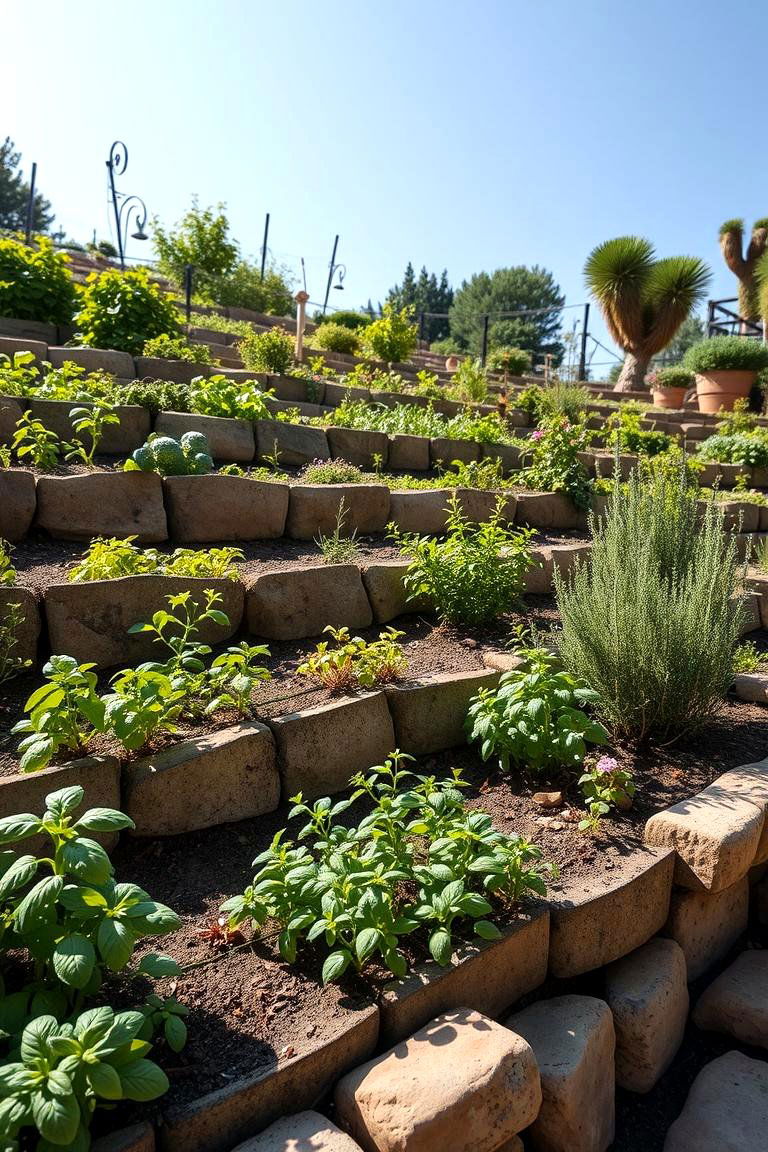
By integrating an herb garden into a slope, gardeners create a functional and aromatic space that elevates culinary creativity. A variety of herbs such as basil, thyme, and mint are planted in strategically designed terraces, ensuring optimal sunlight and drainage. The sloping layout enhances both accessibility and visual interest, while natural retaining walls add rustic charm. This design not only supports fresh, flavorful ingredients year-round but also encourages sustainable gardening practices. The delightful aroma and practicality of an herb garden on a slope make it an ideal retreat for culinary enthusiasts and nature lovers alike.
14. Cottage Garden on a Slope

These charming cottage gardens bring nostalgic beauty to sloping landscapes with a mix of informal design and colorful blooms. Winding pathways, quaint archways, and a medley of flowering shrubs create an inviting atmosphere reminiscent of storybook settings. The natural incline is embraced with creative planting beds that overflow with roses, delphiniums, and other traditional favorites. This design fosters a relaxed, whimsical environment that feels both timeless and intimate. Gardeners can enjoy a peaceful, picturesque retreat that perfectly marries practicality with romantic, old-world charm.
15. Mixed Tree Planting Slope
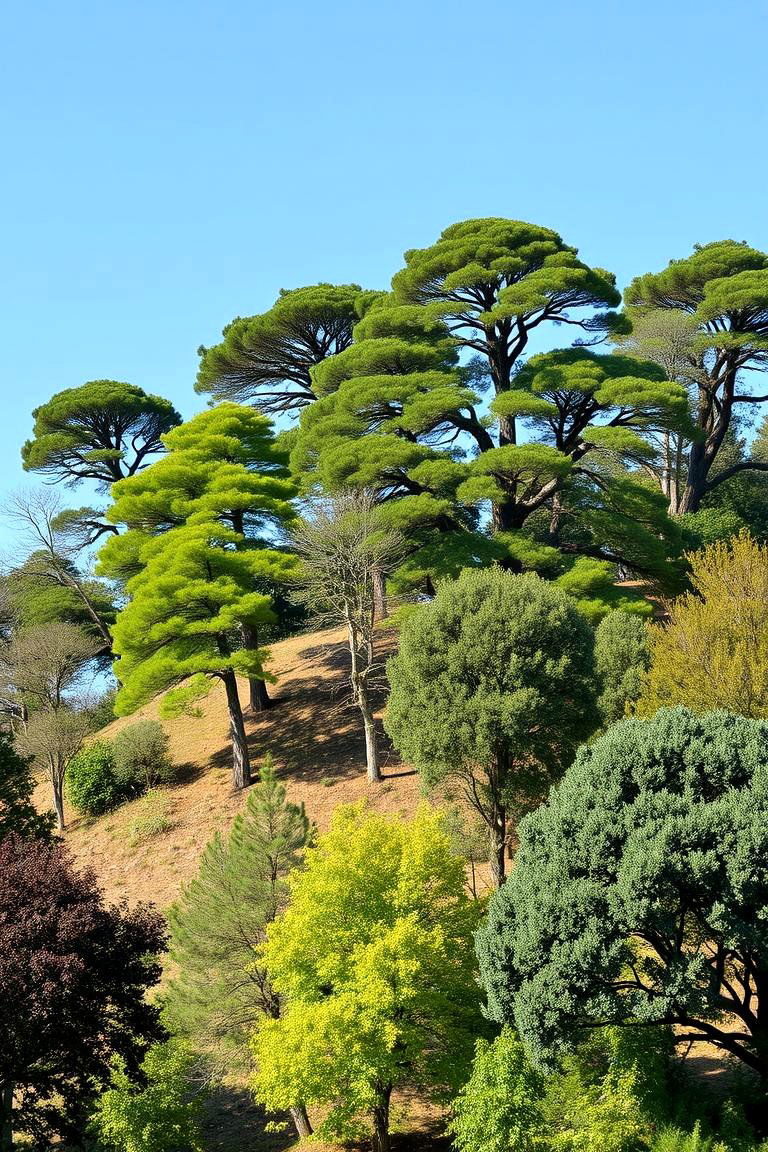
By layering mixed tree plantings, a sloped garden can achieve both beauty and ecological stability. Carefully chosen trees of varying heights and species create a natural canopy that offers shade and year-round interest. This design not only combats soil erosion but also attracts birds and beneficial wildlife. The interplay of textures and seasonal colors enhances the overall visual appeal. The strategic placement of trees transforms the slope into a vibrant ecosystem, blending functionality with aesthetic delight. Enjoy the natural rhythm and the inviting ambiance that this thoughtful arrangement brings to your outdoor space.
16. Eco-friendly Rain Garden
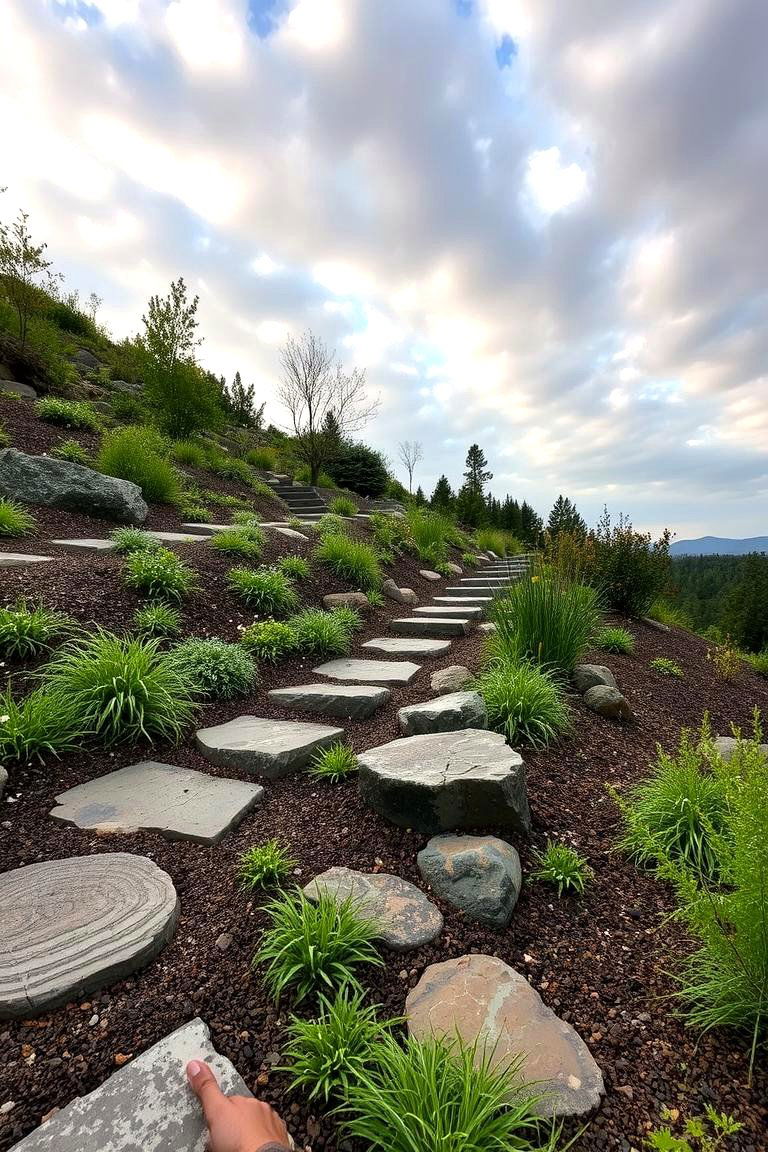
With eco-friendly rain gardens, slopes become practical landscapes that capture and utilize runoff efficiently. Strategically planted with water-loving species, these gardens reduce erosion and improve water quality. The design integrates permeable surfaces, allowing rainwater to filter through rich, organic soil. This sustainable method not only protects the environment but also adds a dynamic, ever-changing beauty to the garden. By embracing natural cycles and using native plants, the rain garden offers both ecological benefits and a unique, tranquil aesthetic that encourages mindful water conservation and outdoor enjoyment.
17. Edible Fruit Slope
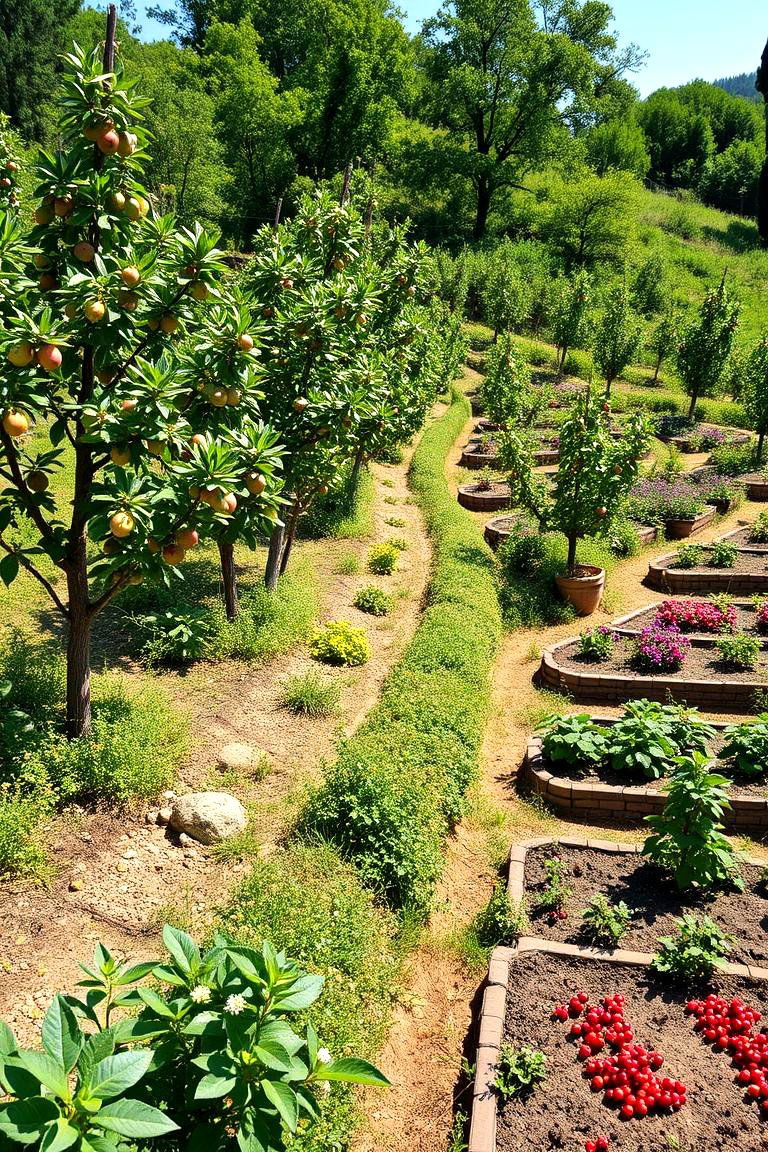
Another innovative concept transforms a slope into an edible fruit garden where dwarf fruit trees and berry bushes thrive. The terraced layout ensures each plant receives ample sunlight and proper drainage, encouraging healthy growth and bountiful harvests. This design promotes sustainability and offers a delicious reward for your gardening efforts. Integrated irrigation systems and natural mulch further enhance the garden’s productivity. Enjoy the beauty and practicality of a space that produces fresh, seasonal fruit while doubling as a picturesque landscape feature that enriches your outdoor living area.
18. Succulent Rockery Garden
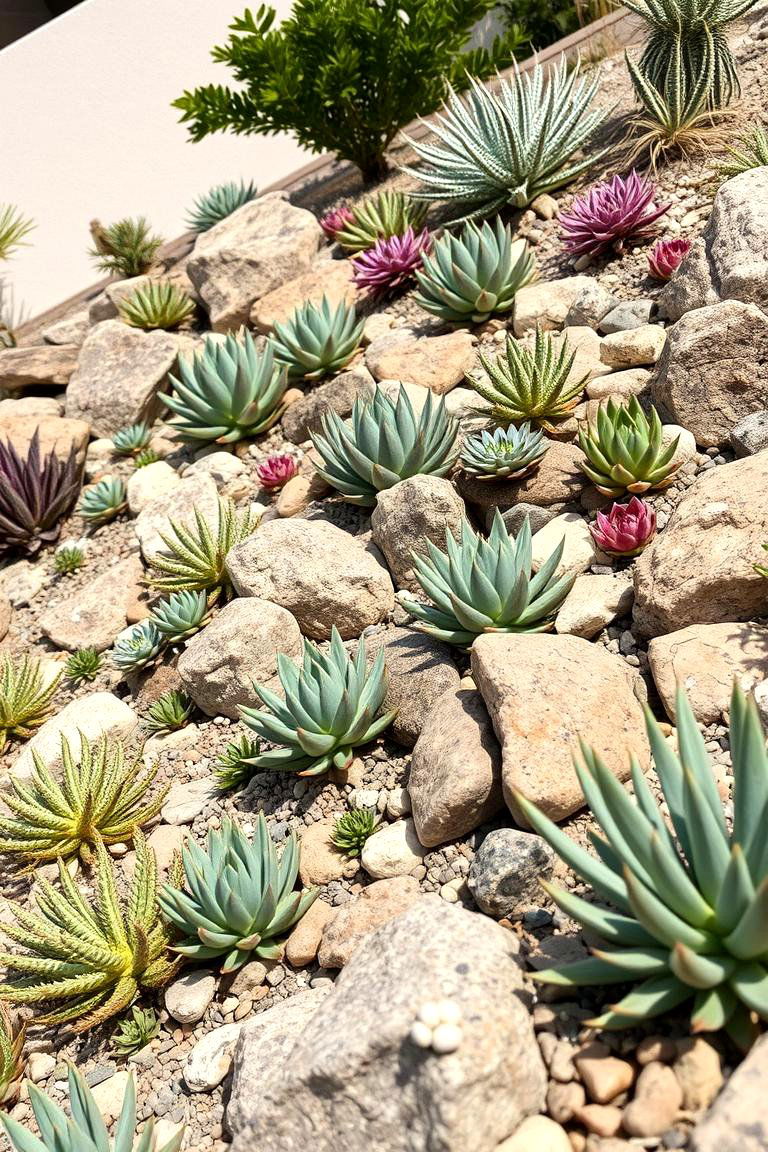
These succulent rockery gardens creatively utilize drought-resistant succulents to add modern flair on a slope. With carefully arranged stones and varied textures, the garden exudes a contemporary yet natural vibe. The unique selection of low-water succulents, cacti, and ornamental grasses minimizes maintenance while offering striking visual contrast. The design emphasizes precise placement and balanced composition, ensuring a cohesive look that adapts to the challenging terrain. Enjoy a minimalist, sustainable garden that combines practicality with artistic expression, turning a difficult slope into a stylish retreat.
19. Contemporary Minimalist Slope Garden

Unlike traditional designs, contemporary minimalist slope gardens focus on clean lines and open space. This approach uses a limited color palette with well-defined plant groupings and simple hardscape elements that enhance the natural slope. The uncluttered design encourages a sense of calm and order, highlighting both the landscape’s inherent beauty and modern sensibilities. Functional yet artistic, the minimalist garden offers a low-maintenance solution that emphasizes quality over quantity. The result is a refined, elegant space that invites both relaxation and appreciation for subtle, contemporary design.
20. Rain Shadow Garden
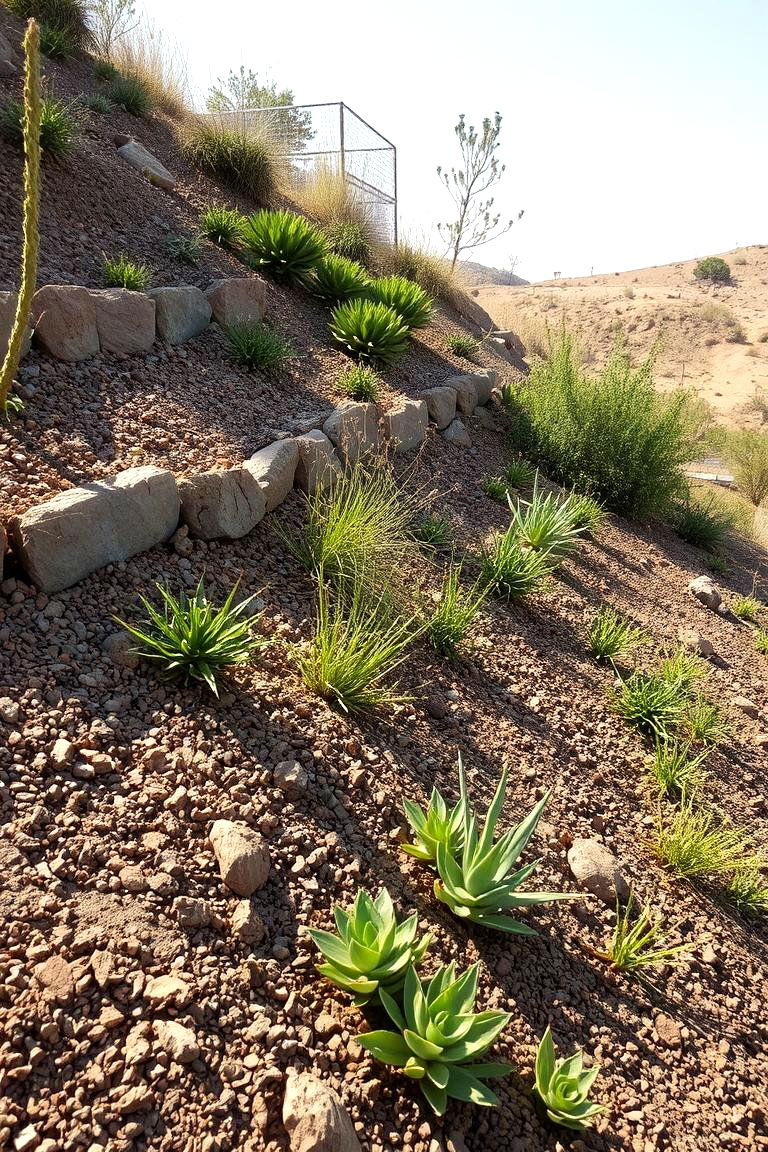
By embracing a rain shadow garden concept, slopes can be transformed into thriving microclimates with drier conditions. This design employs drought-resistant plants and smart water management techniques to create an appealing, low-water landscape. Thoughtfully arranged layers and textured elements help control erosion and offer visual interest throughout the year. Gardeners enjoy the unique interplay of light, shadow, and arid beauty that defines this style. The innovative approach provides both environmental benefits and an attractive, sustainable solution tailored for slopes with limited water availability.
21. Layered Bamboo Retreat
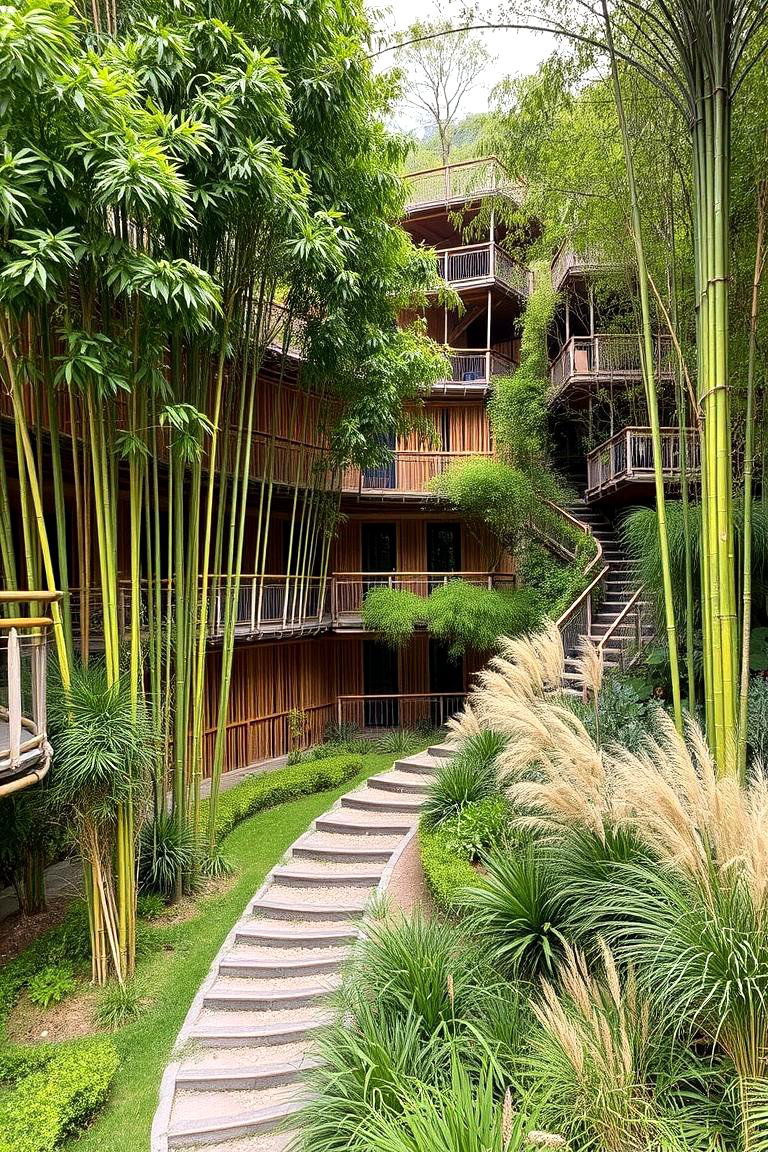
To create a serene retreat, layered bamboo gardens use the natural elegance of bamboo to soften a slope’s incline. Multiple tiers of bamboo, interspersed with ornamental grasses and ferns, establish a calming, green sanctuary. The vertical lines and gentle rustle of leaves evoke a peaceful atmosphere, perfect for quiet contemplation. This design not only provides privacy but also promotes natural cooling and windbreak benefits. The layered planting enhances both aesthetic appeal and ecological function, transforming the slope into an inviting, eco-friendly haven that radiates tranquility and balance.
22. Moss and Fern Slope Garden
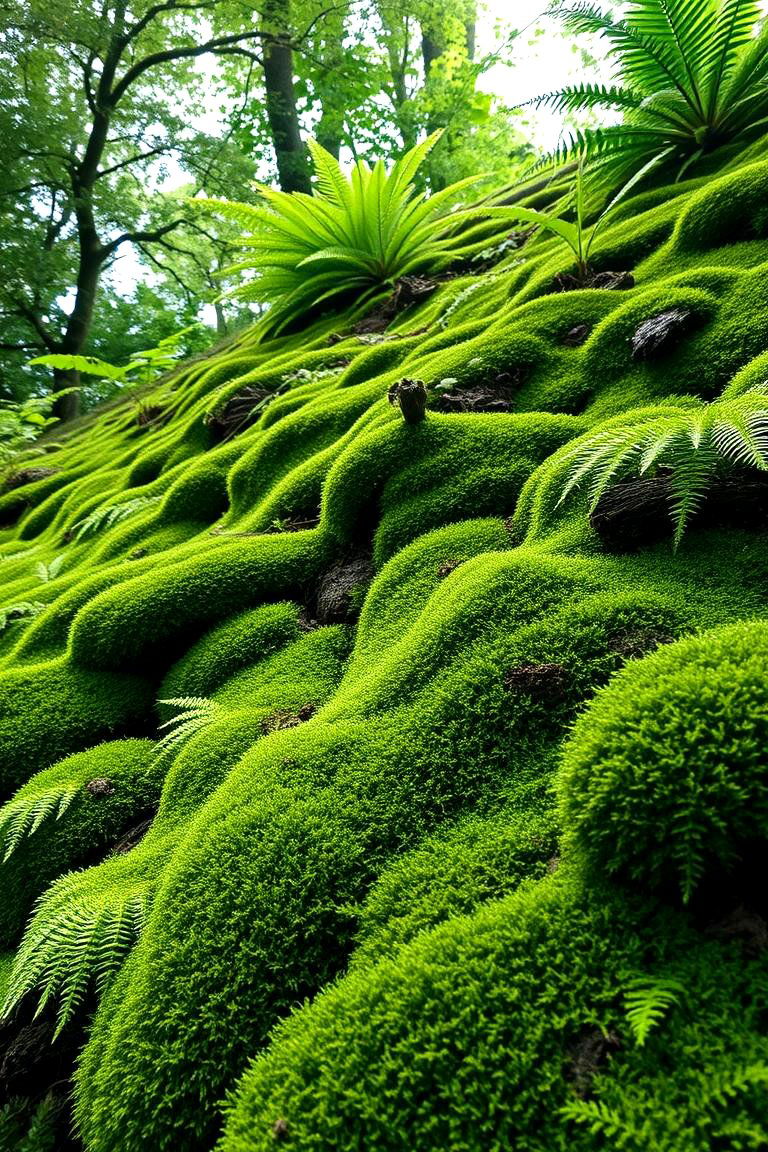
These enchanting moss and fern gardens infuse a slope with lush, green textures that evoke a woodland retreat. A variety of shade-loving ferns and soft, velvety moss combine to create a cool, inviting environment, ideal for those seeking a natural escape. The design emphasizes organic growth and natural moisture retention, reducing erosion while celebrating delicate foliage. This tranquil setting is perfect for reflective moments and slow-paced enjoyment, where every step reveals nature’s subtle artistry. The result is a harmonious, low-maintenance landscape that enchants and rejuvenates visitors alike.
23. Elevated Garden Walkway
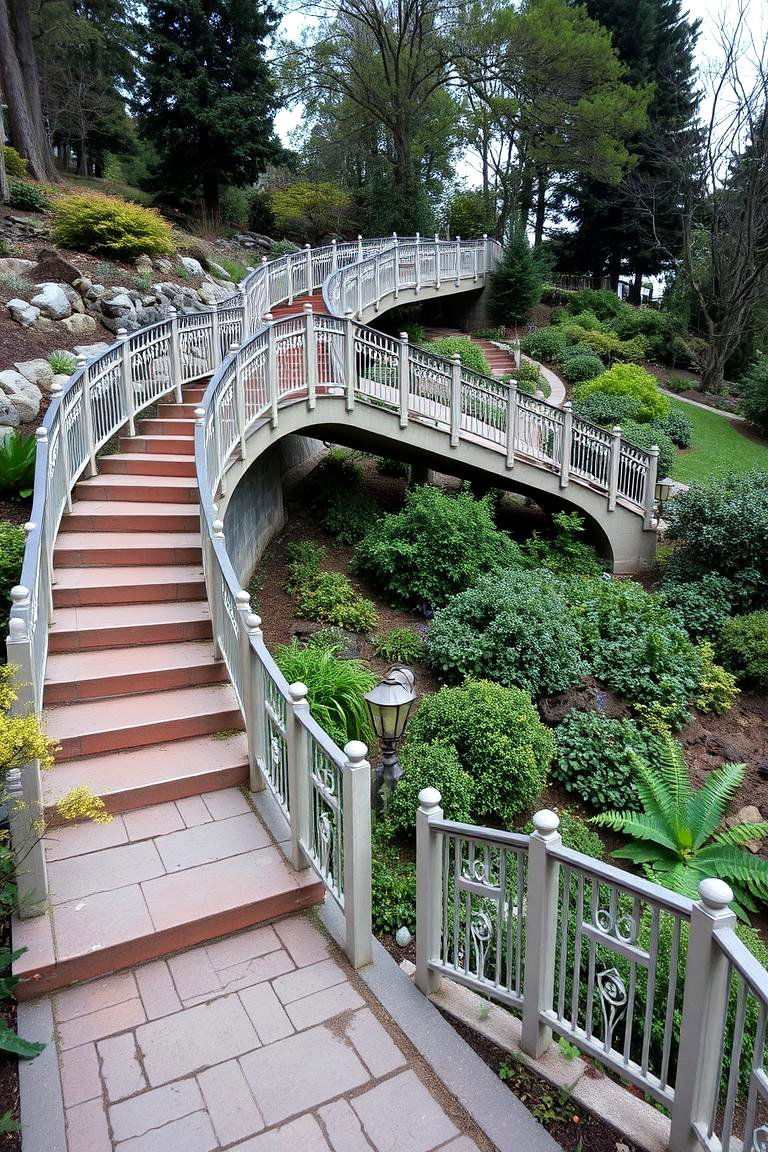
With an elevated garden walkway, a sloped area is transformed into an accessible, meandering path that highlights unique planting schemes. The raised design improves safety and creates distinct garden zones while connecting different levels with charming bridges and steps. Integrated lighting and ornamental railings add visual interest and enhance evening ambiance. This functional feature not only combats erosion but also invites exploration and leisurely strolls. The elevated pathway serves as a focal point that merges practicality with artistic design, offering both aesthetic appeal and enhanced accessibility in a beautifully structured outdoor space.
24. Nighttime Illumination Garden
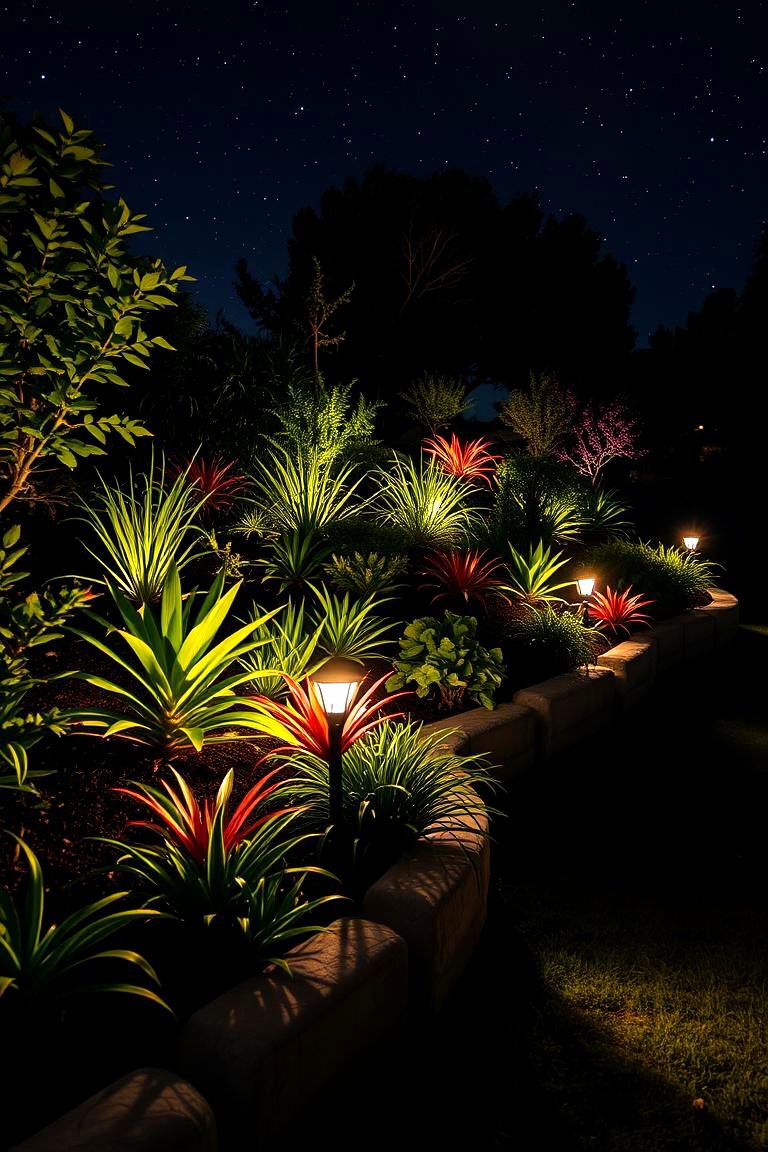
Finally, a nighttime illumination garden transforms slopes into magical spaces after dark. Thoughtfully positioned LED lights and solar-powered fixtures accentuate pathways, plant features, and water elements, creating a mesmerizing play of light and shadow. The design highlights seasonal blooms and structural elements while ensuring safety and reducing energy use. This innovative approach allows gardeners to enjoy their outdoor haven at night, fostering a serene yet vibrant ambiance. The captivating interplay of light elevates the natural beauty of the slope, turning it into an enchanting retreat for evening relaxation.
Conclusion:
Bringing together creative landscaping and practical design, these ideas showcase how sloped gardens can be transformed into vibrant, sustainable retreats. Each concept offers unique benefits—from enhanced accessibility to environmental conservation and aesthetic charm. Enjoy the inspiration and innovative techniques that cater to every gardener’s needs, and let these 24 Sloped Garden Ideas spark your next outdoor transformation.


